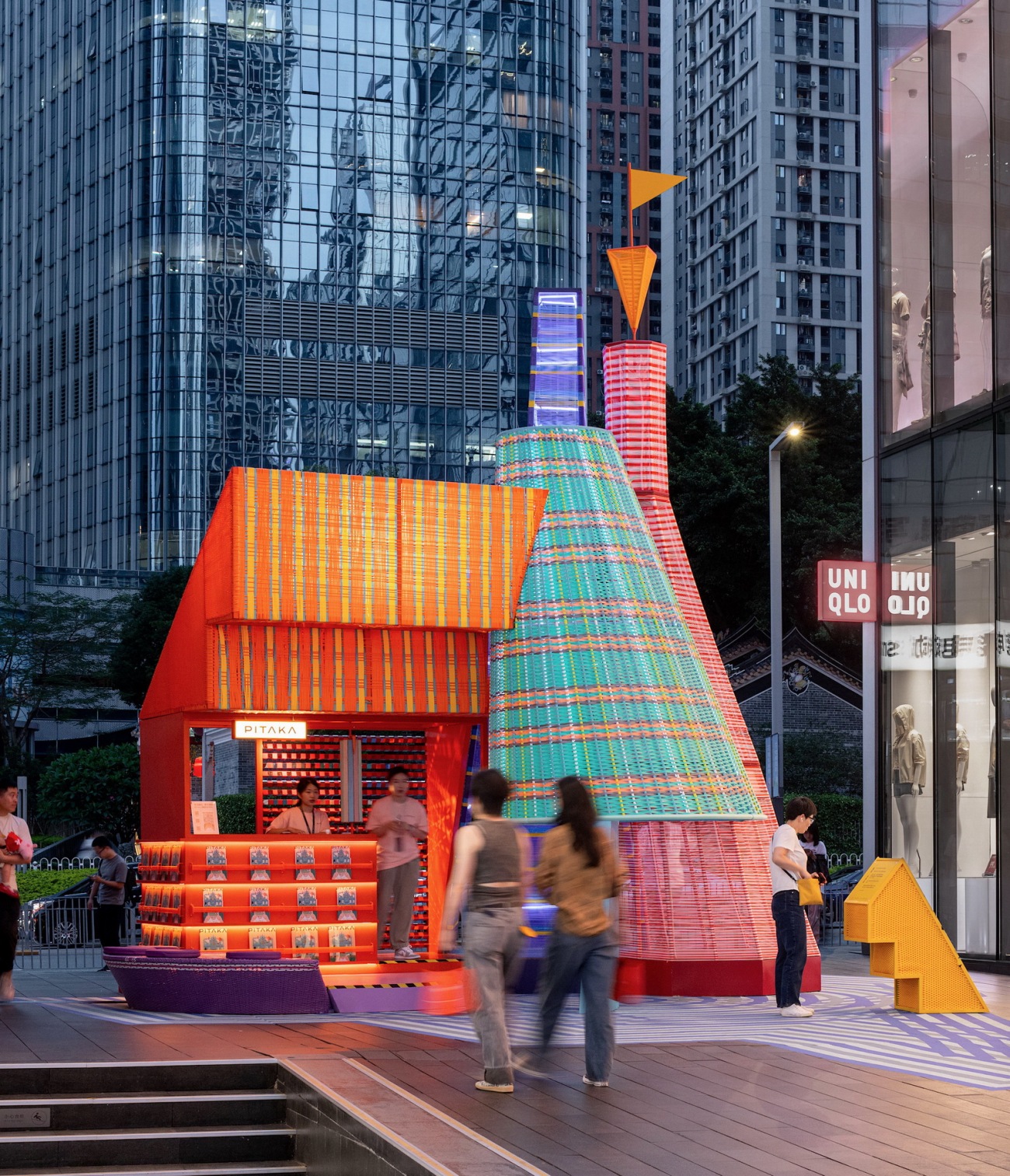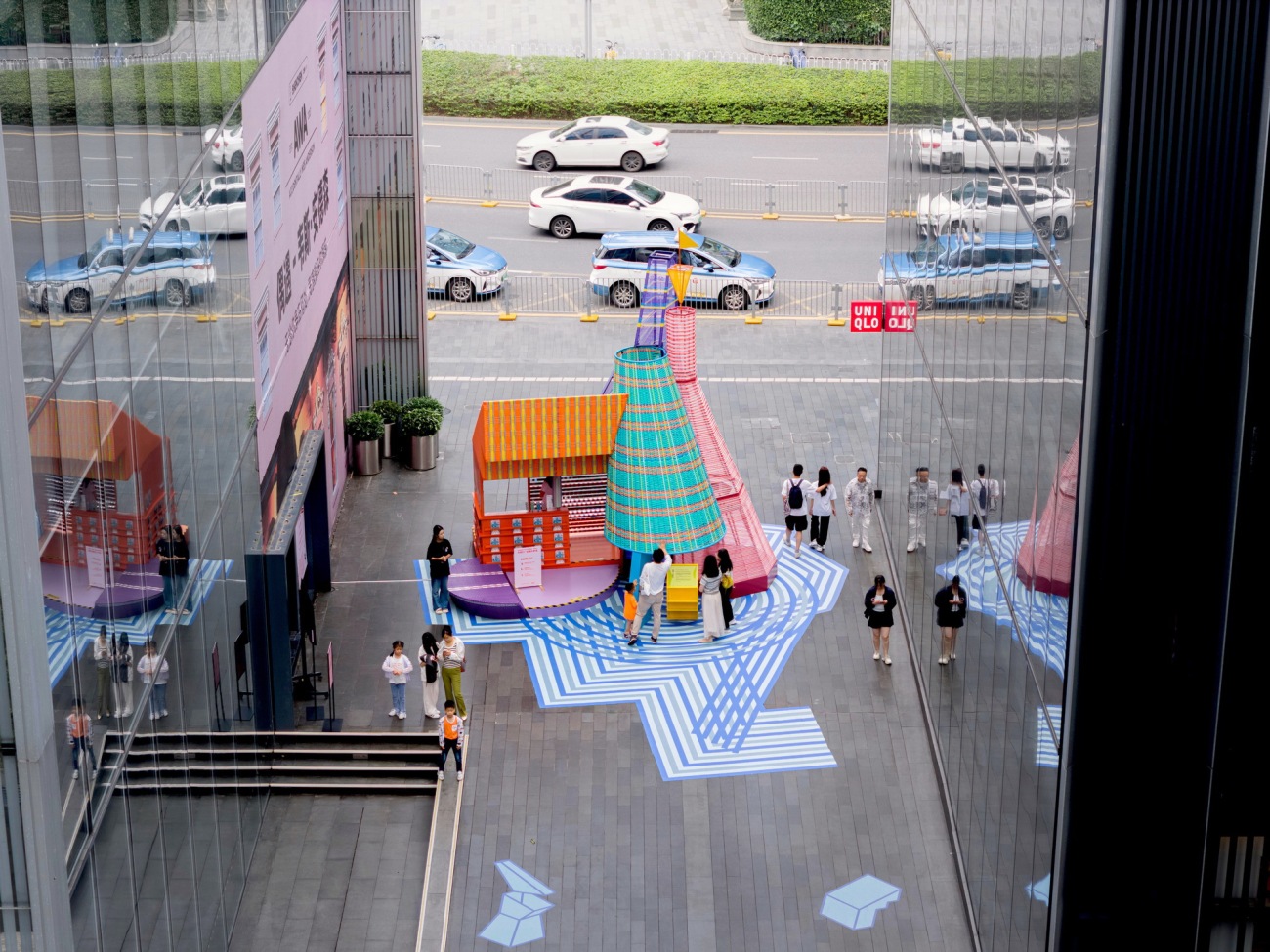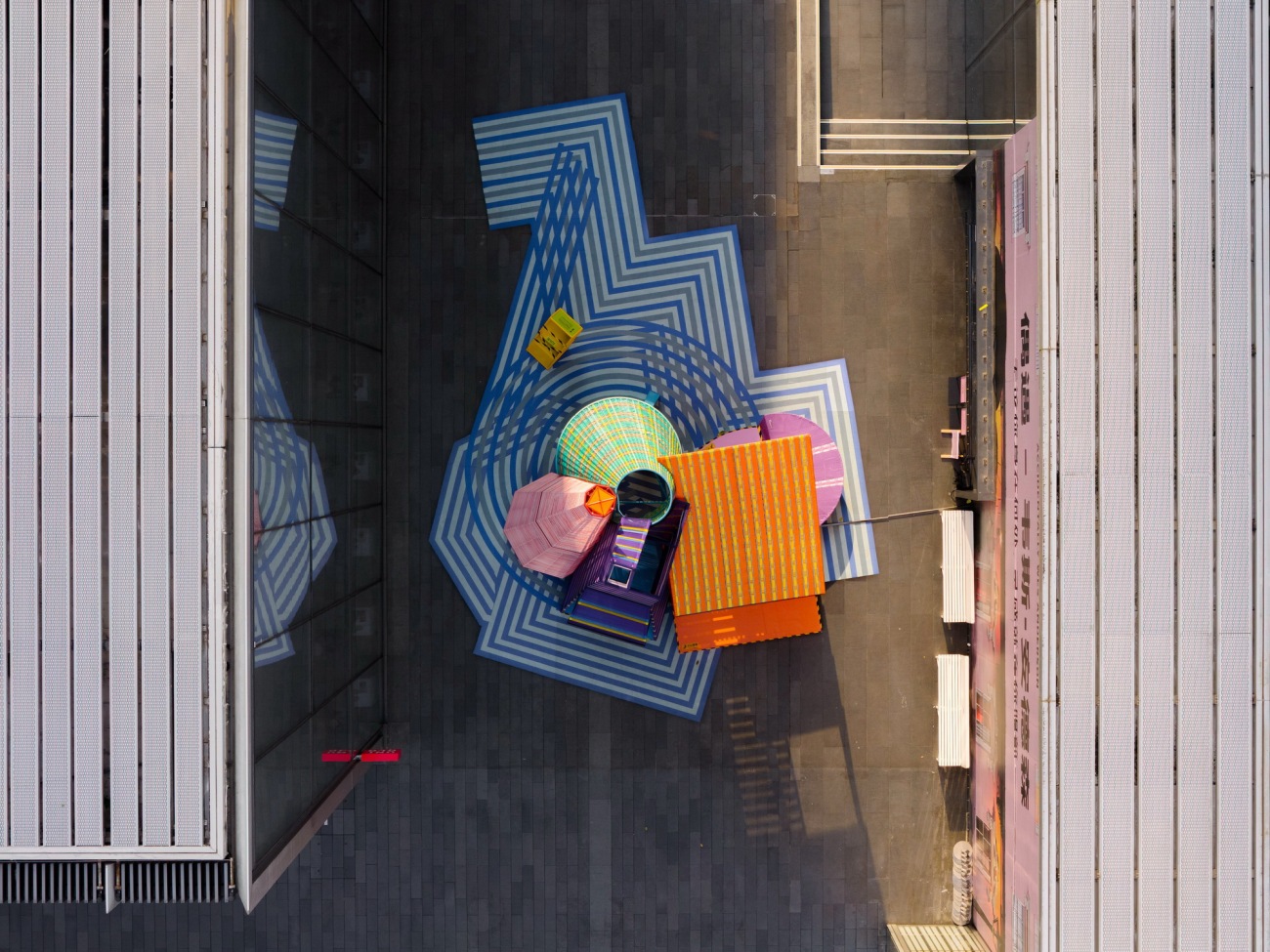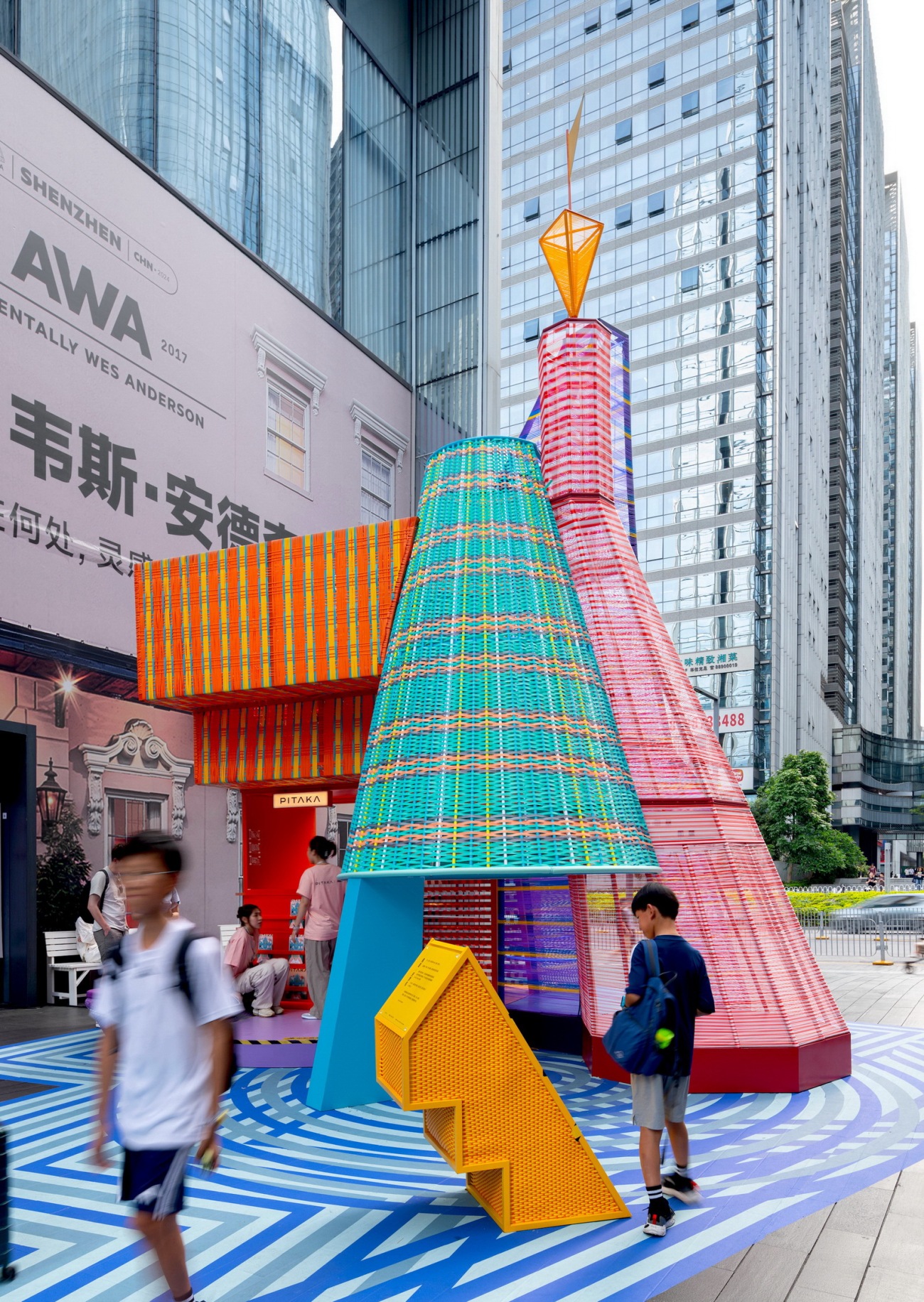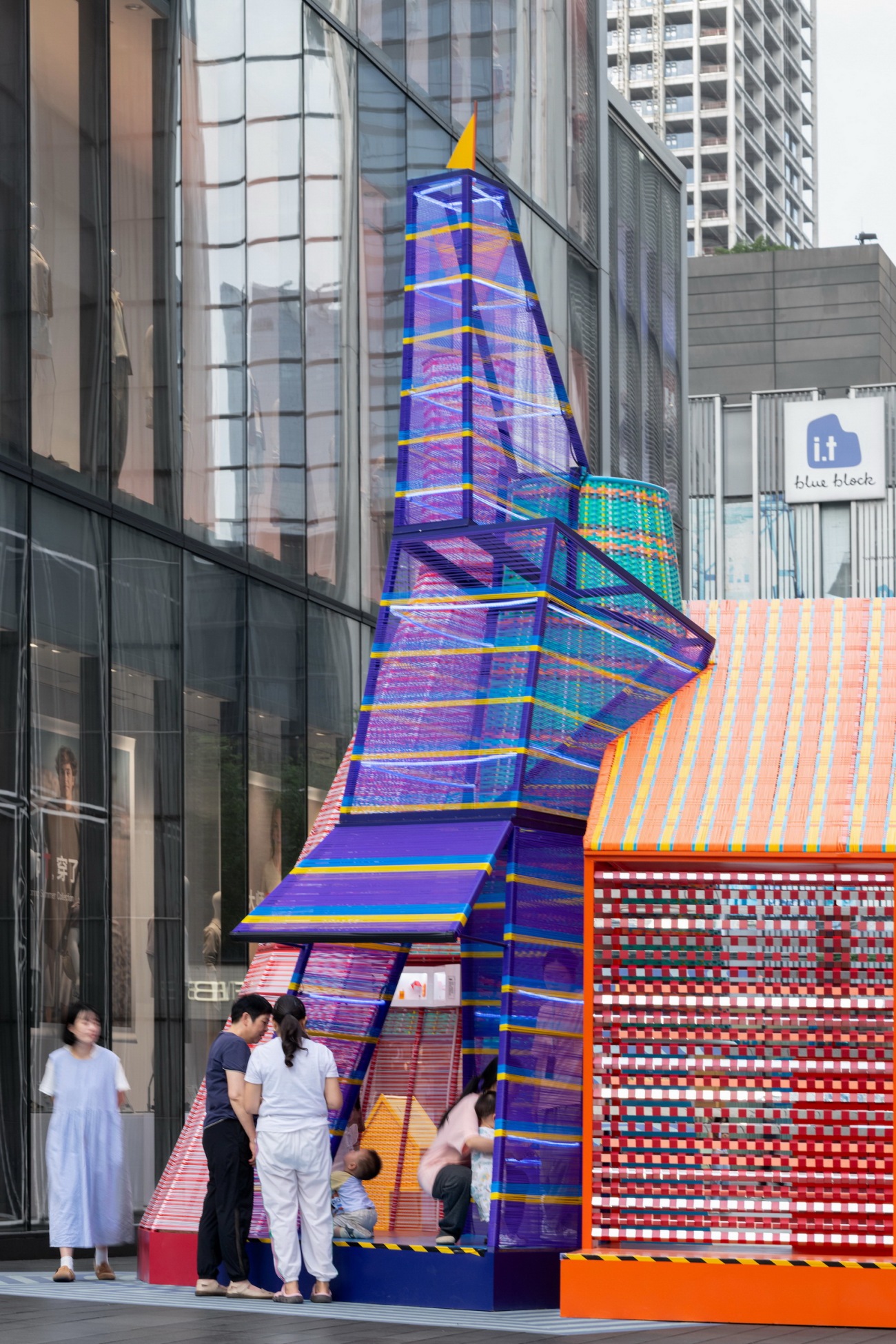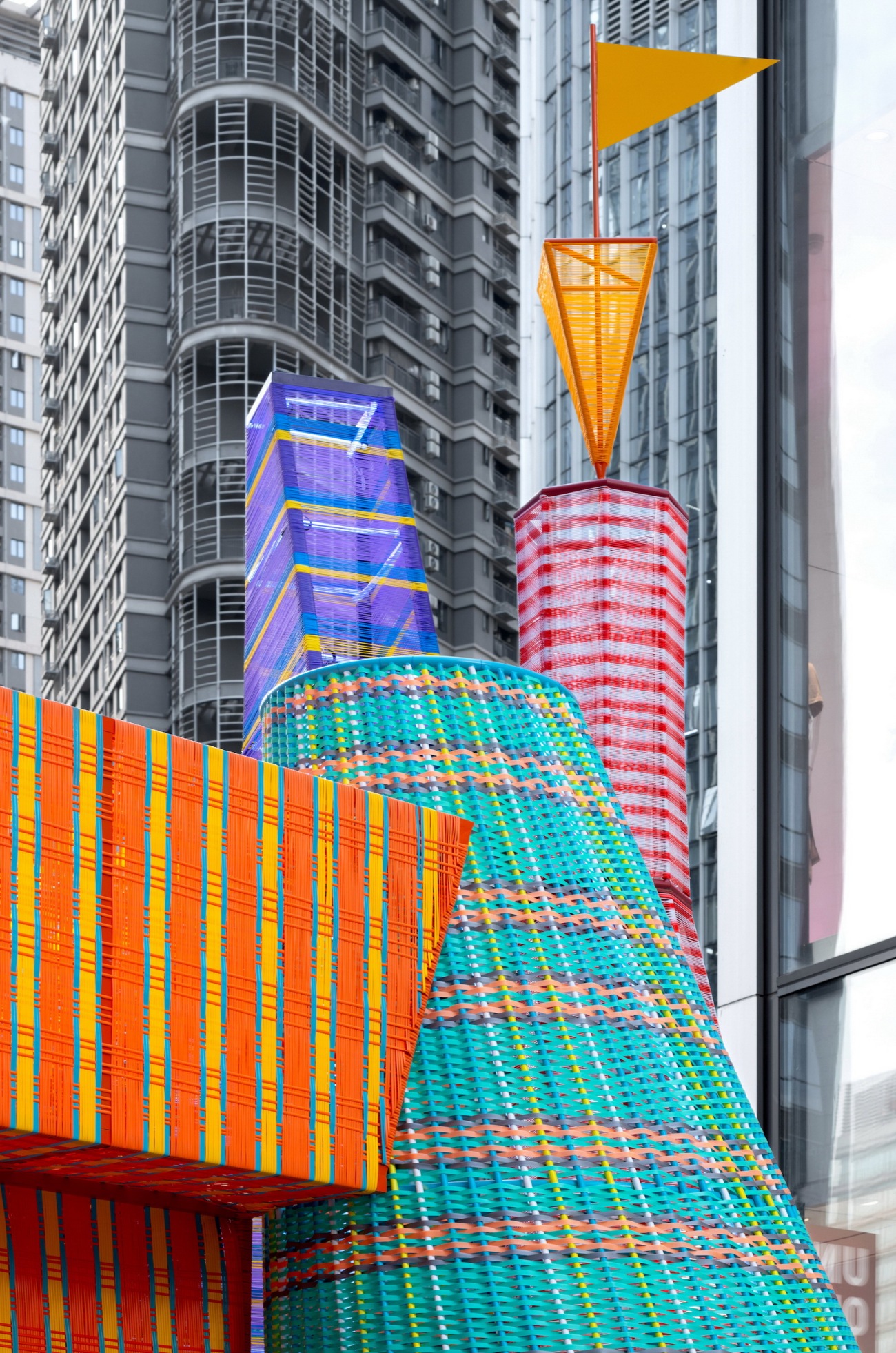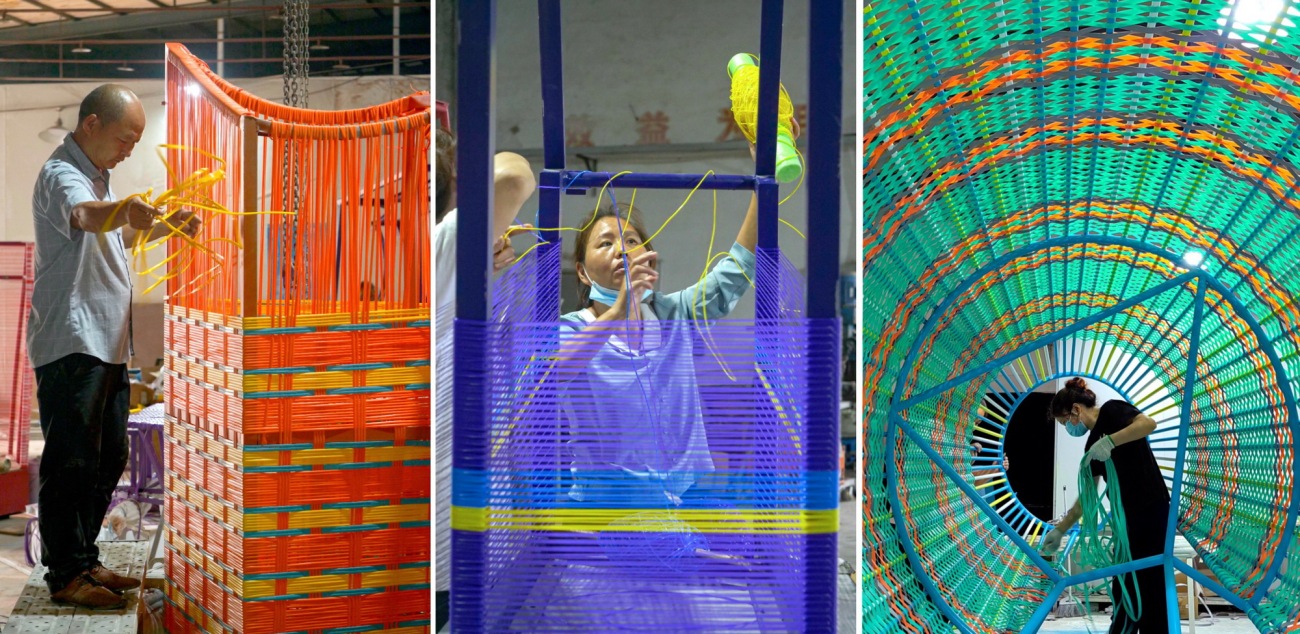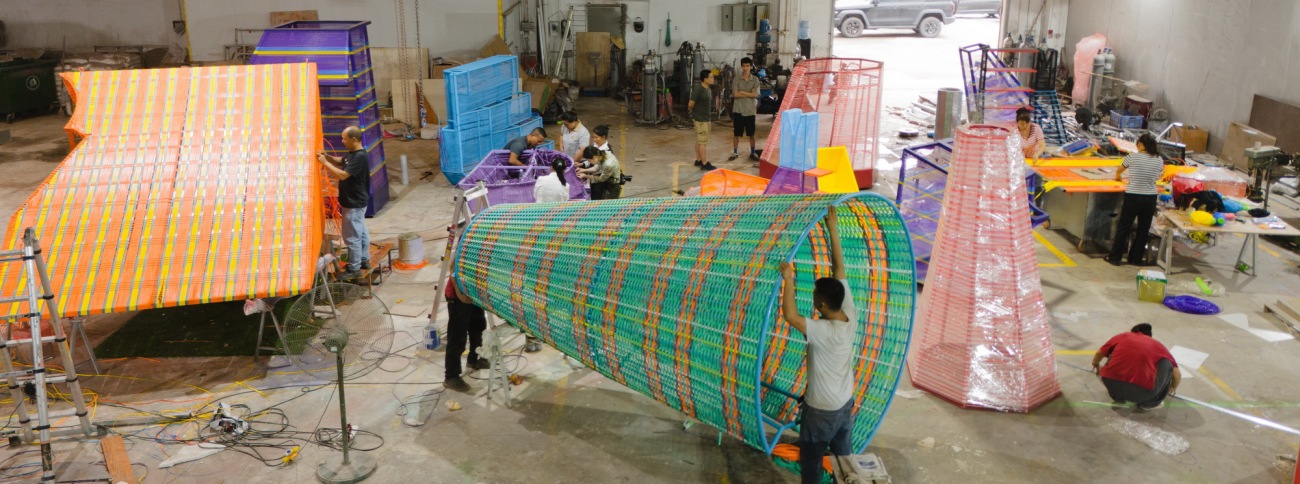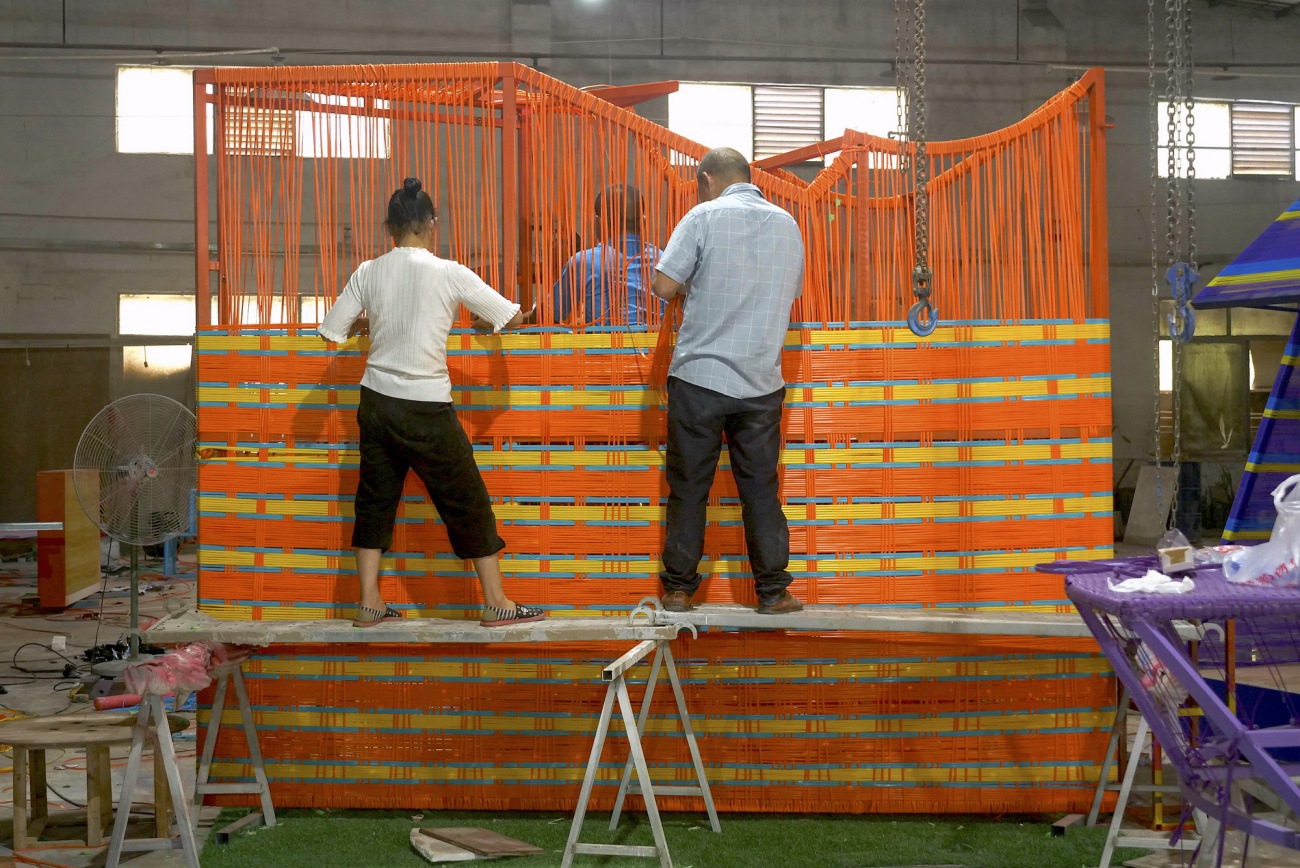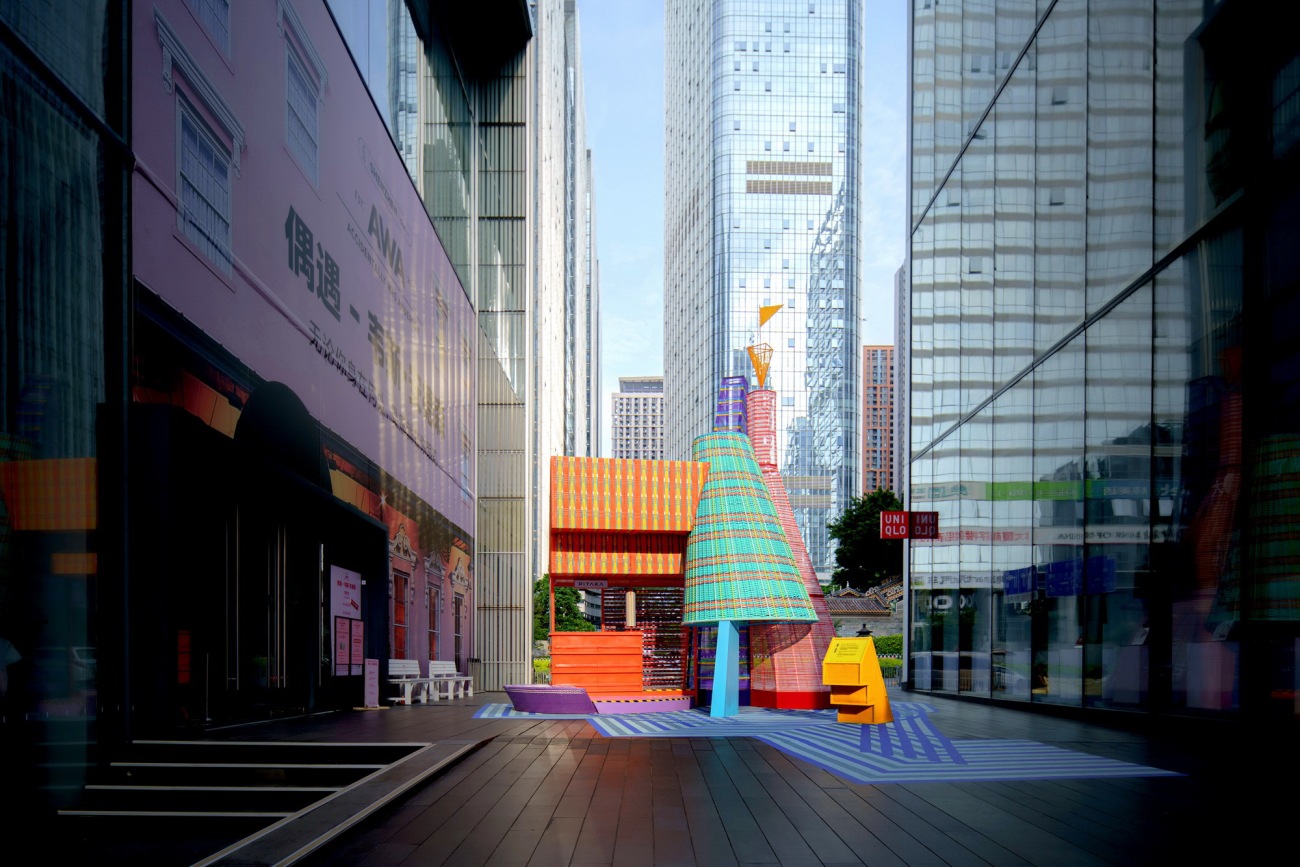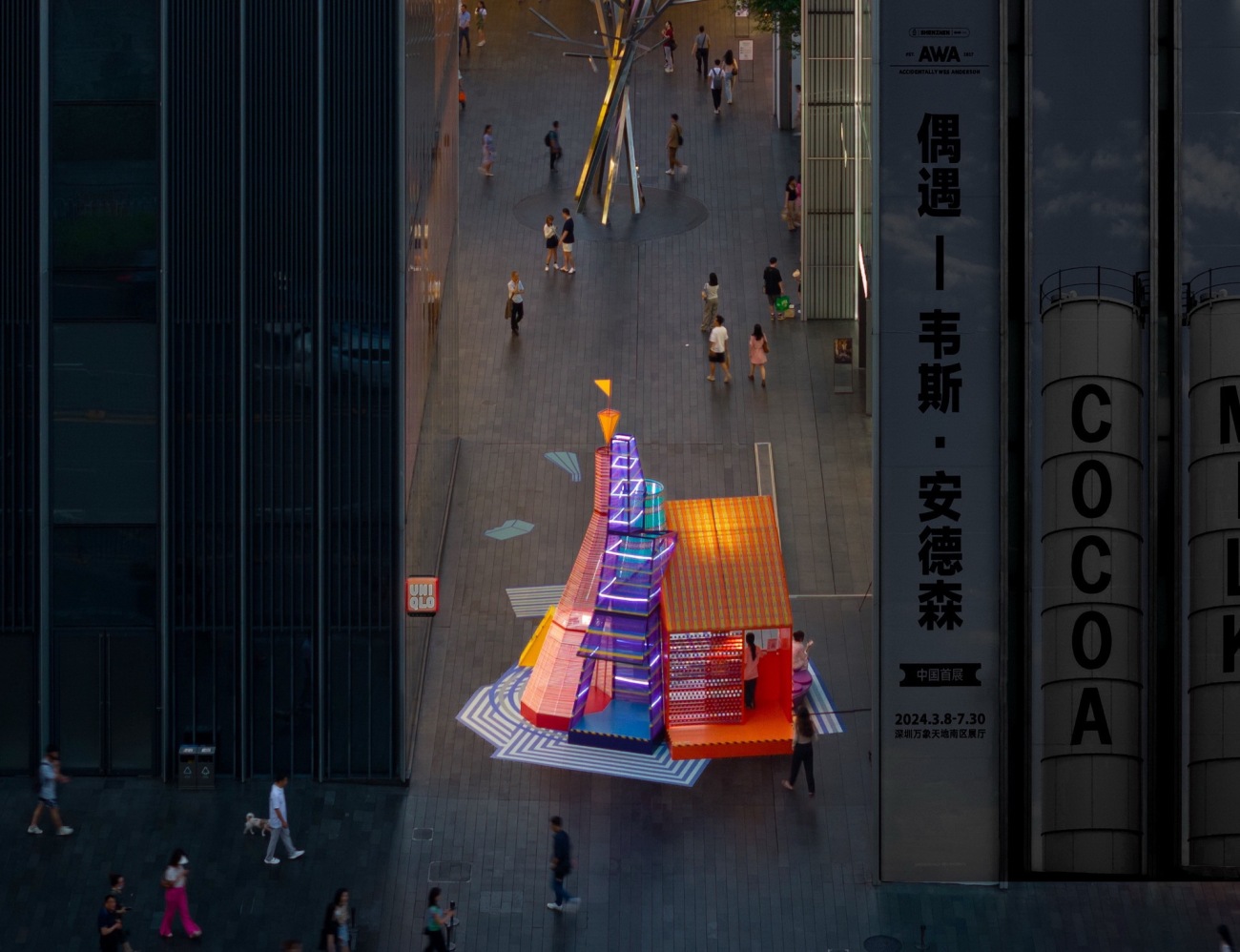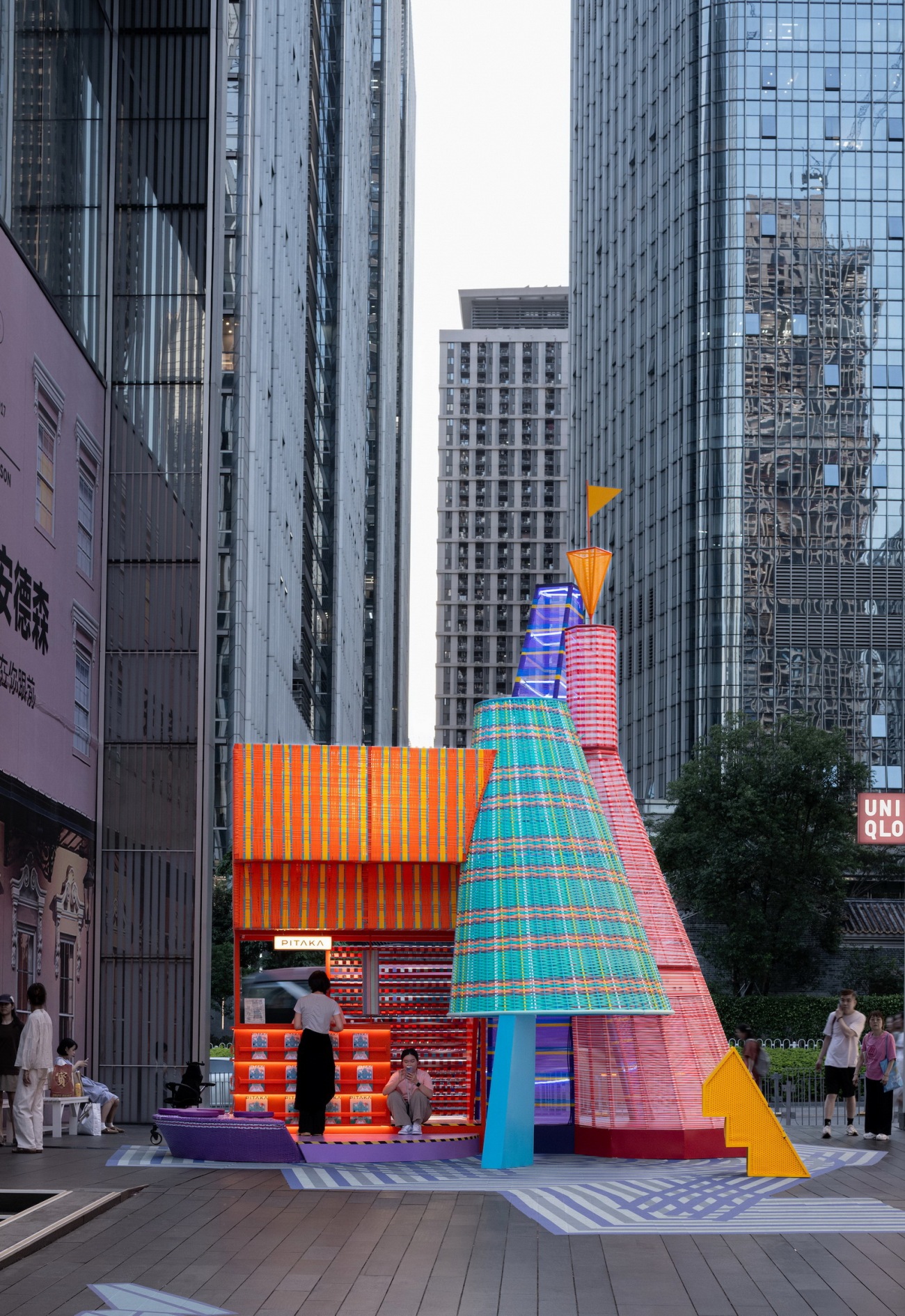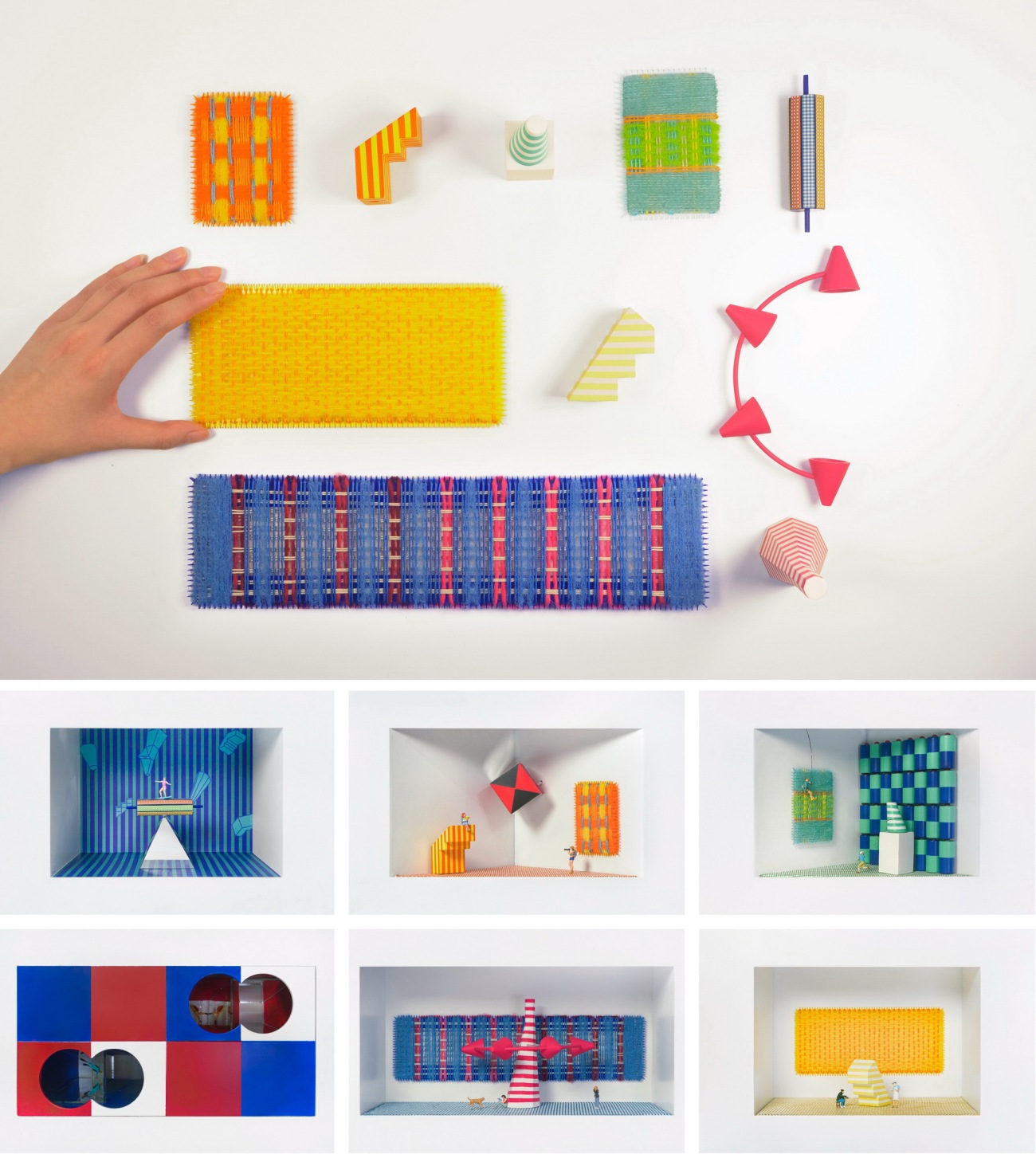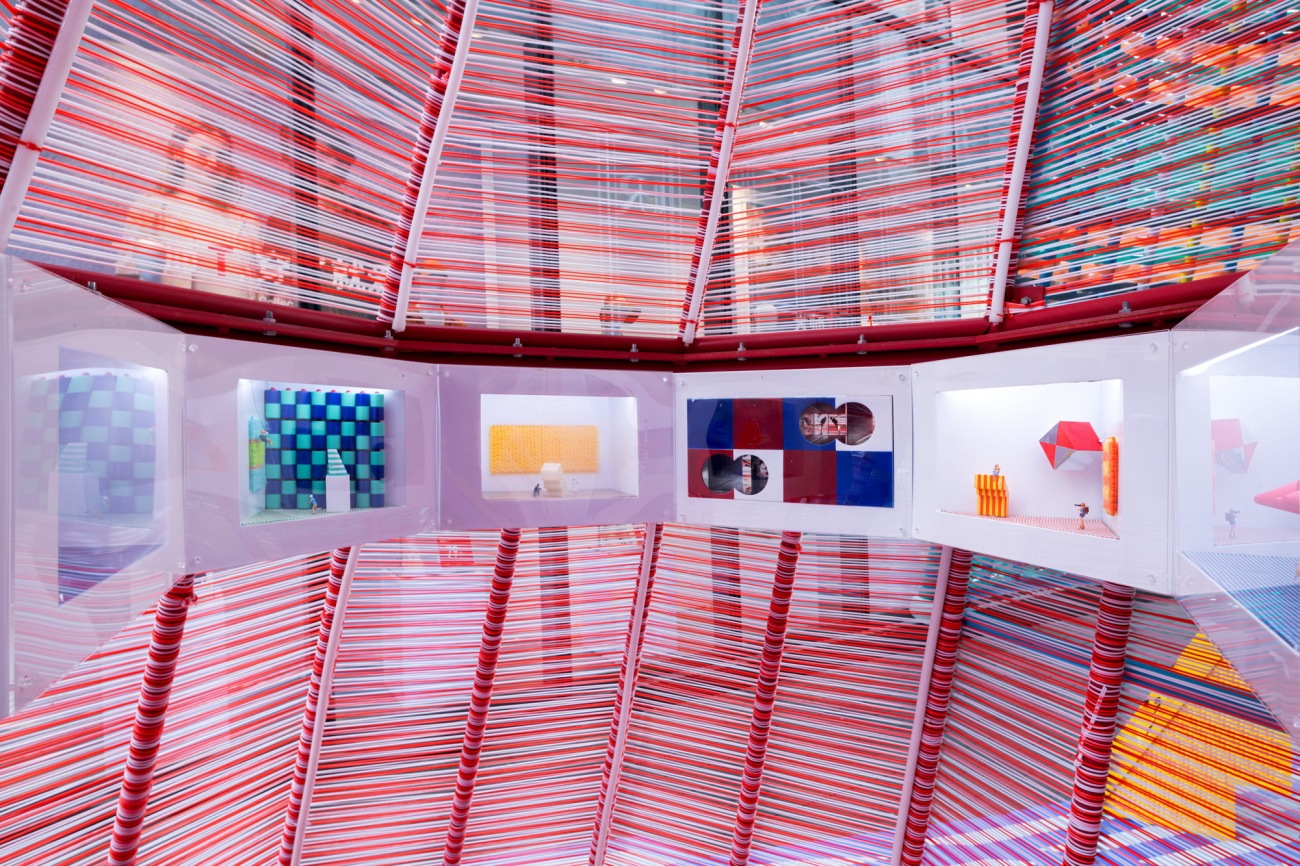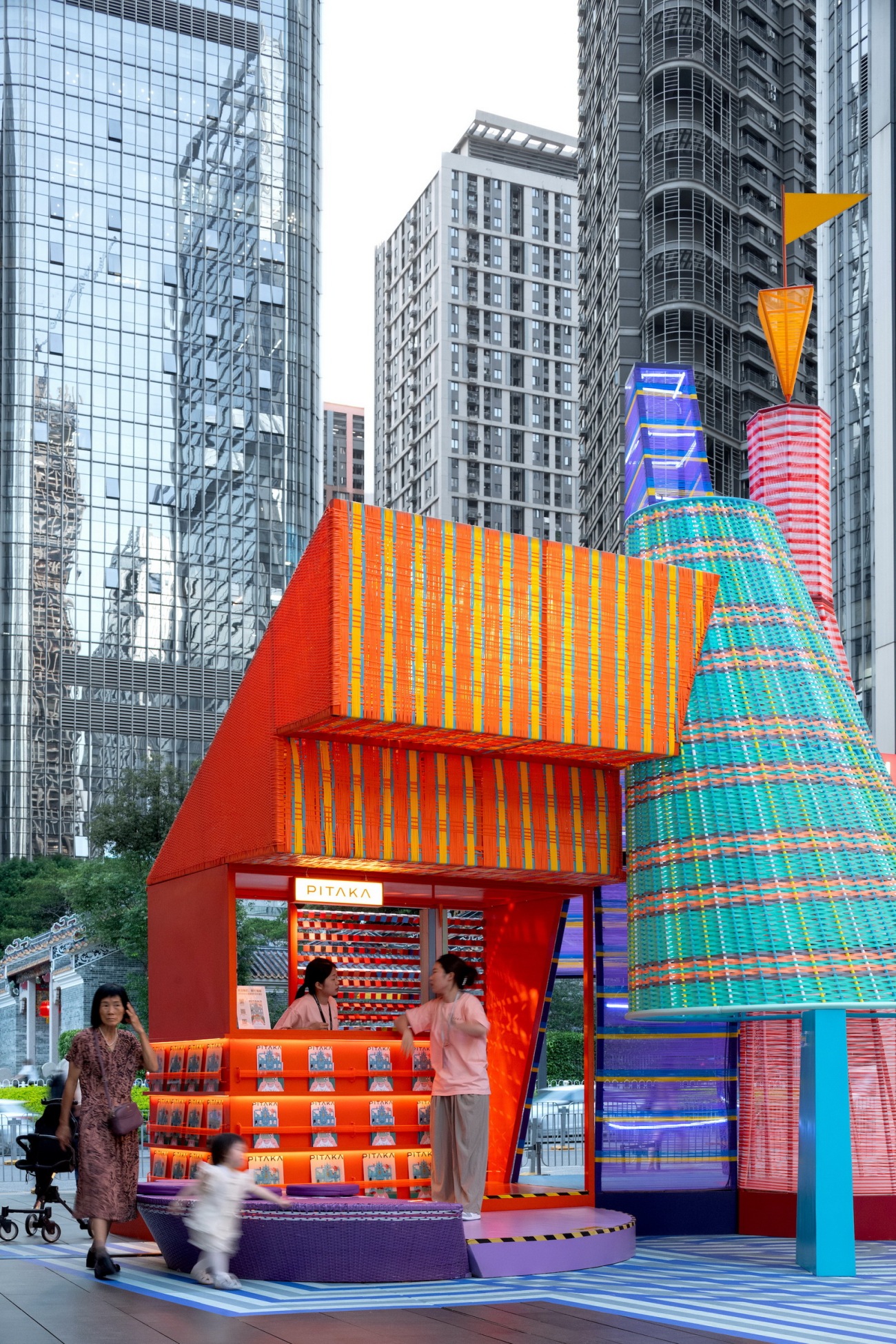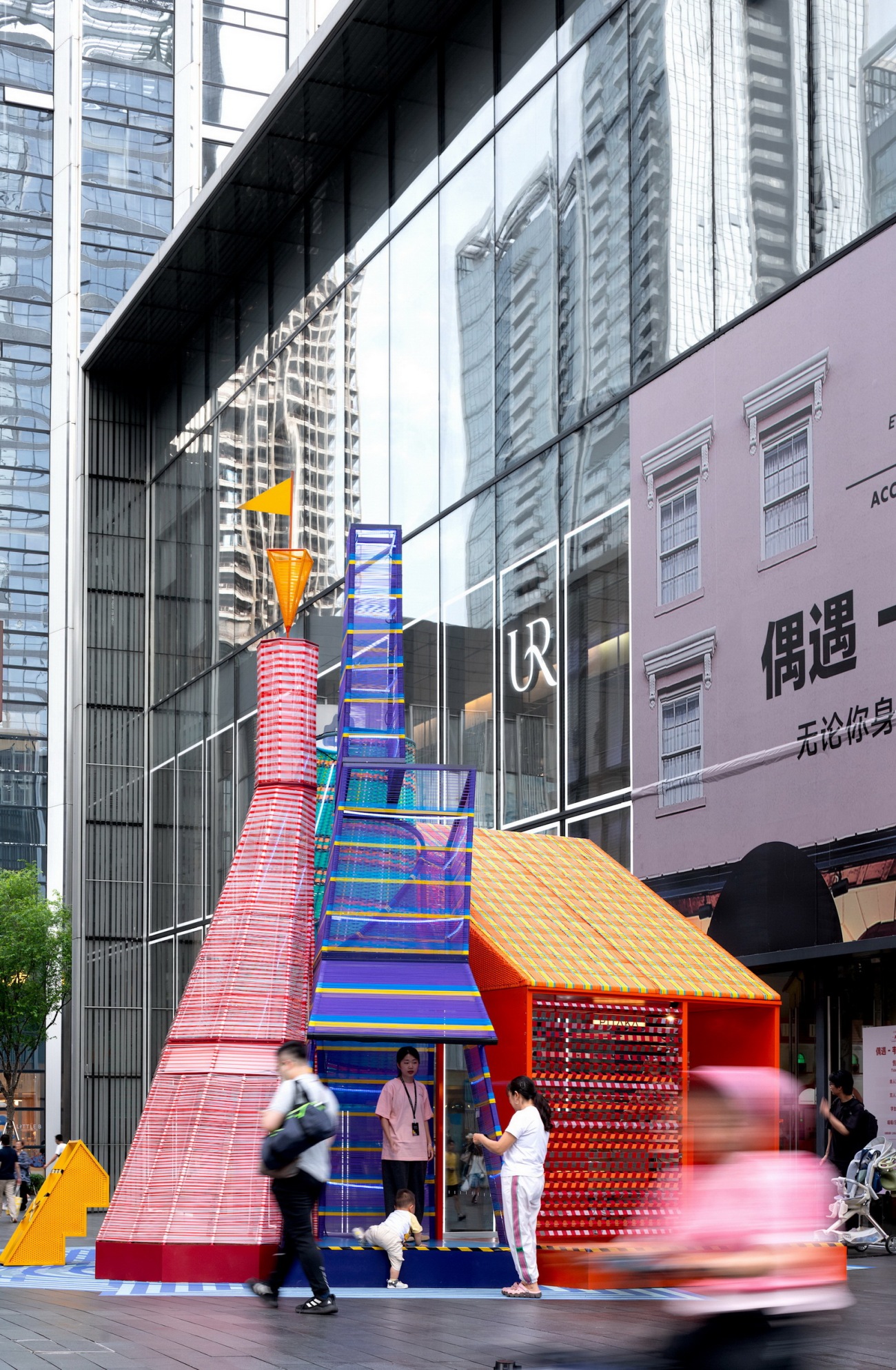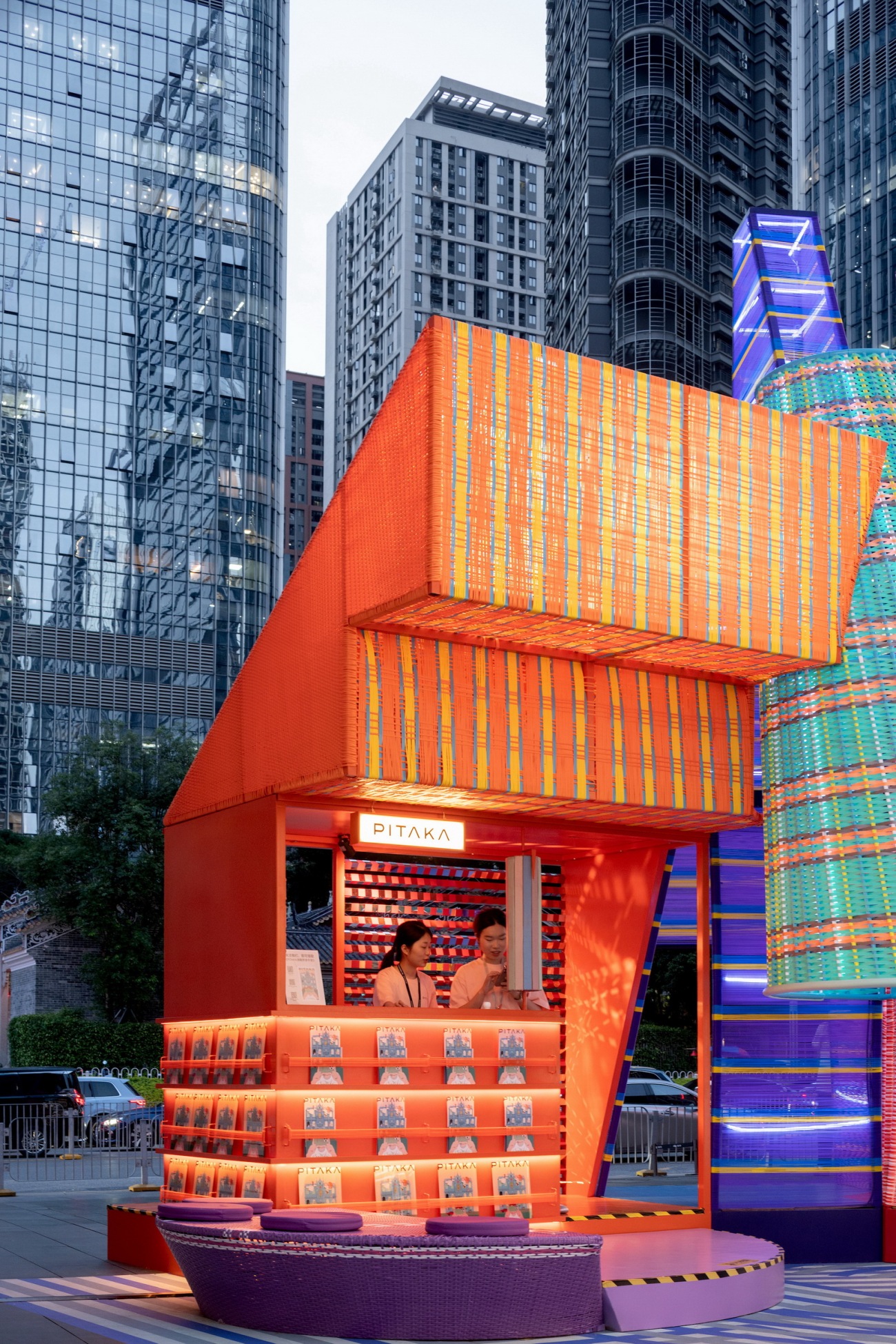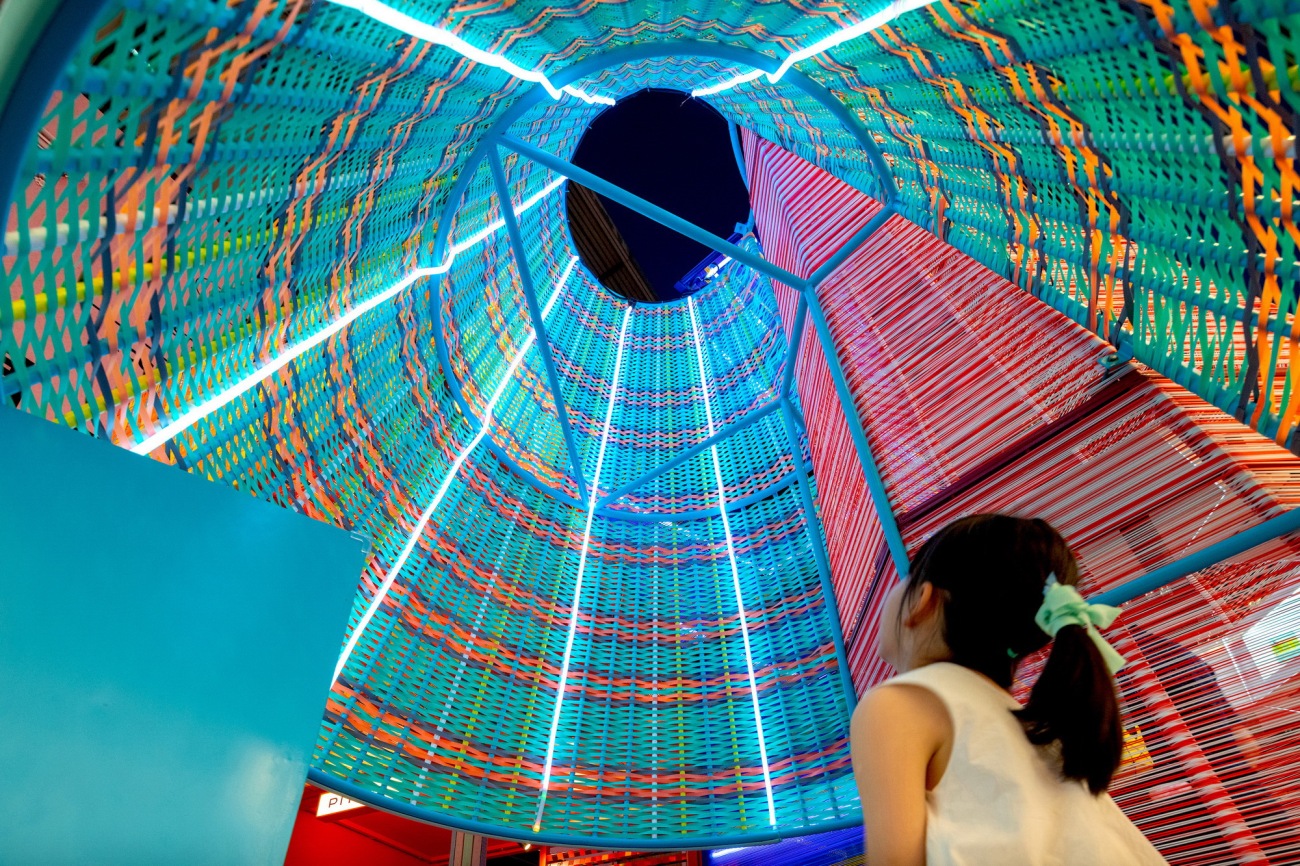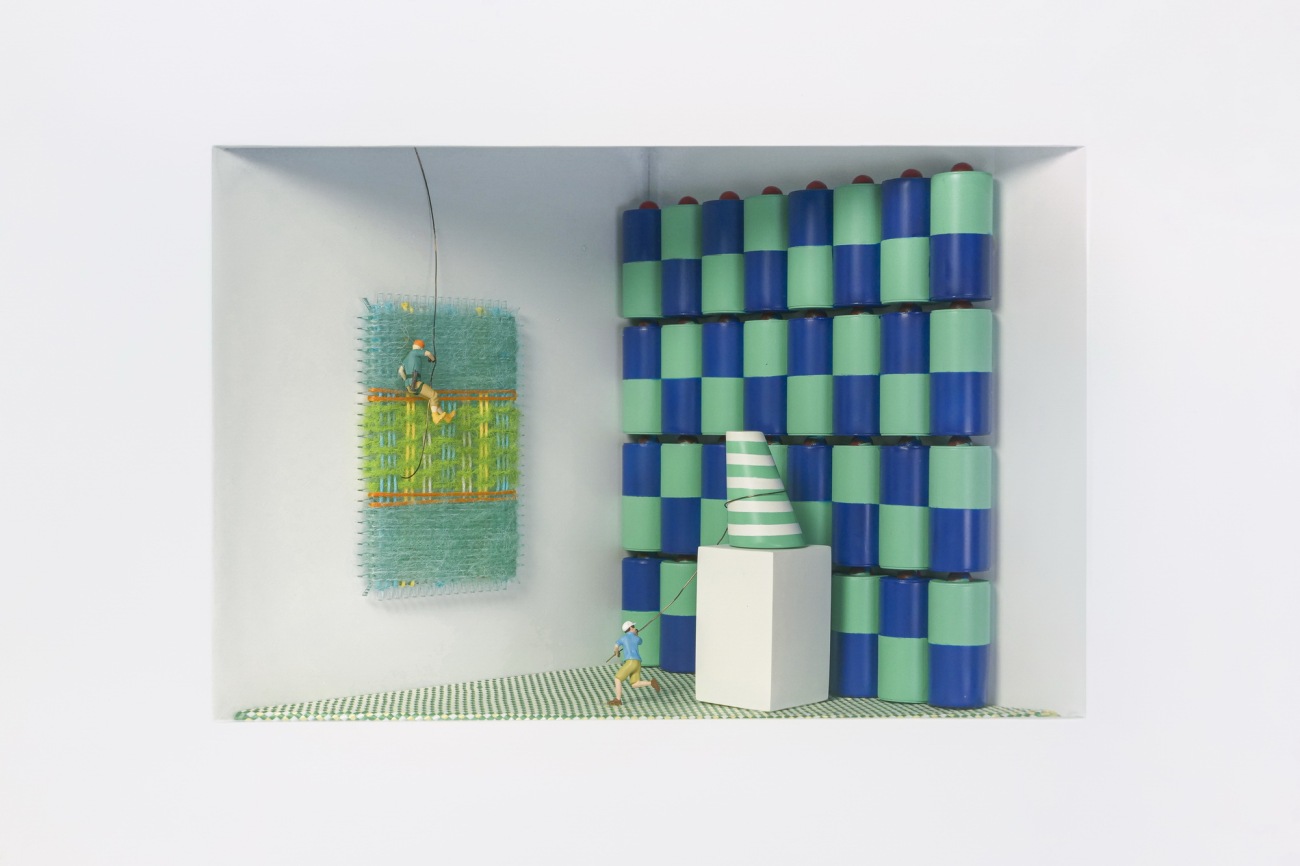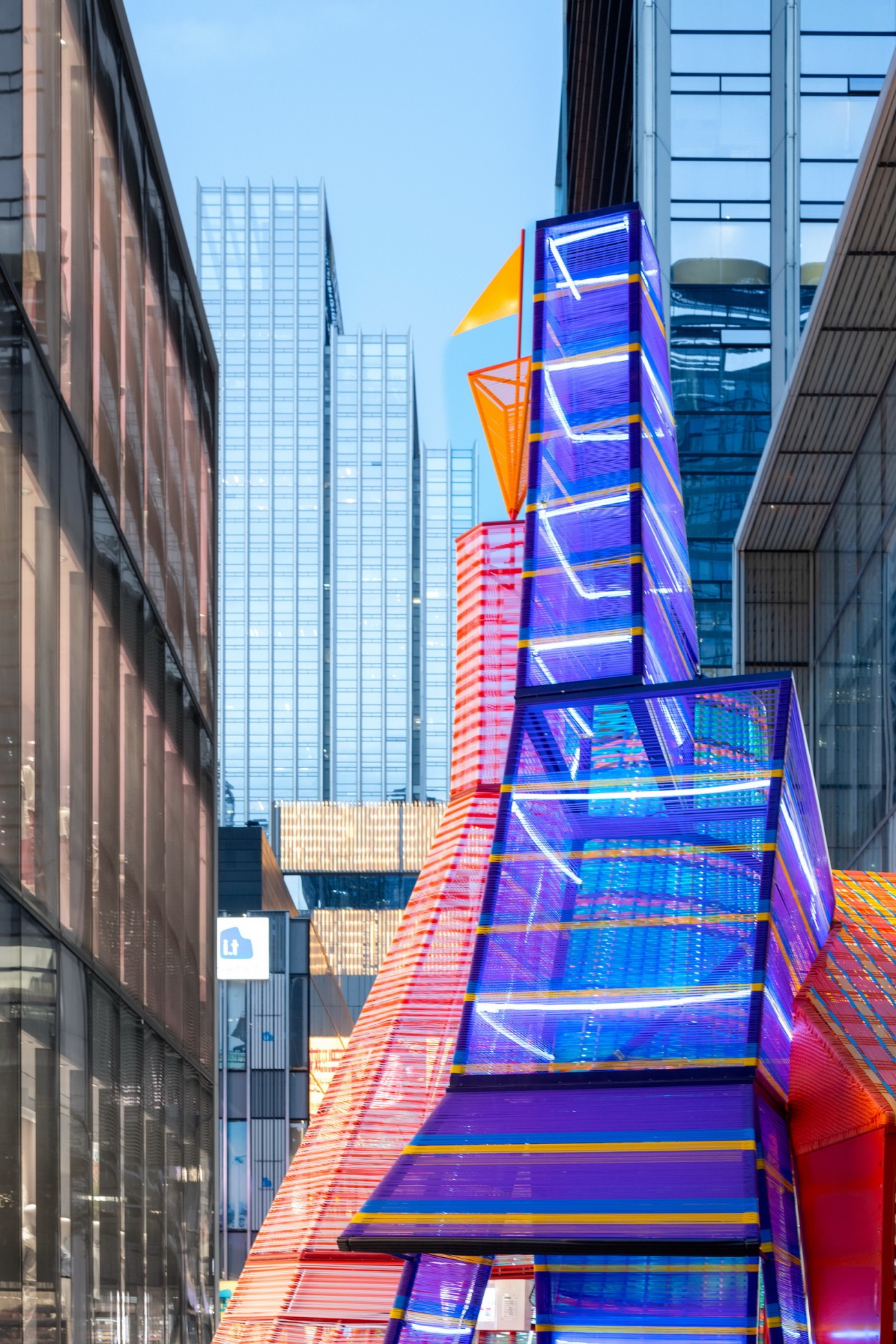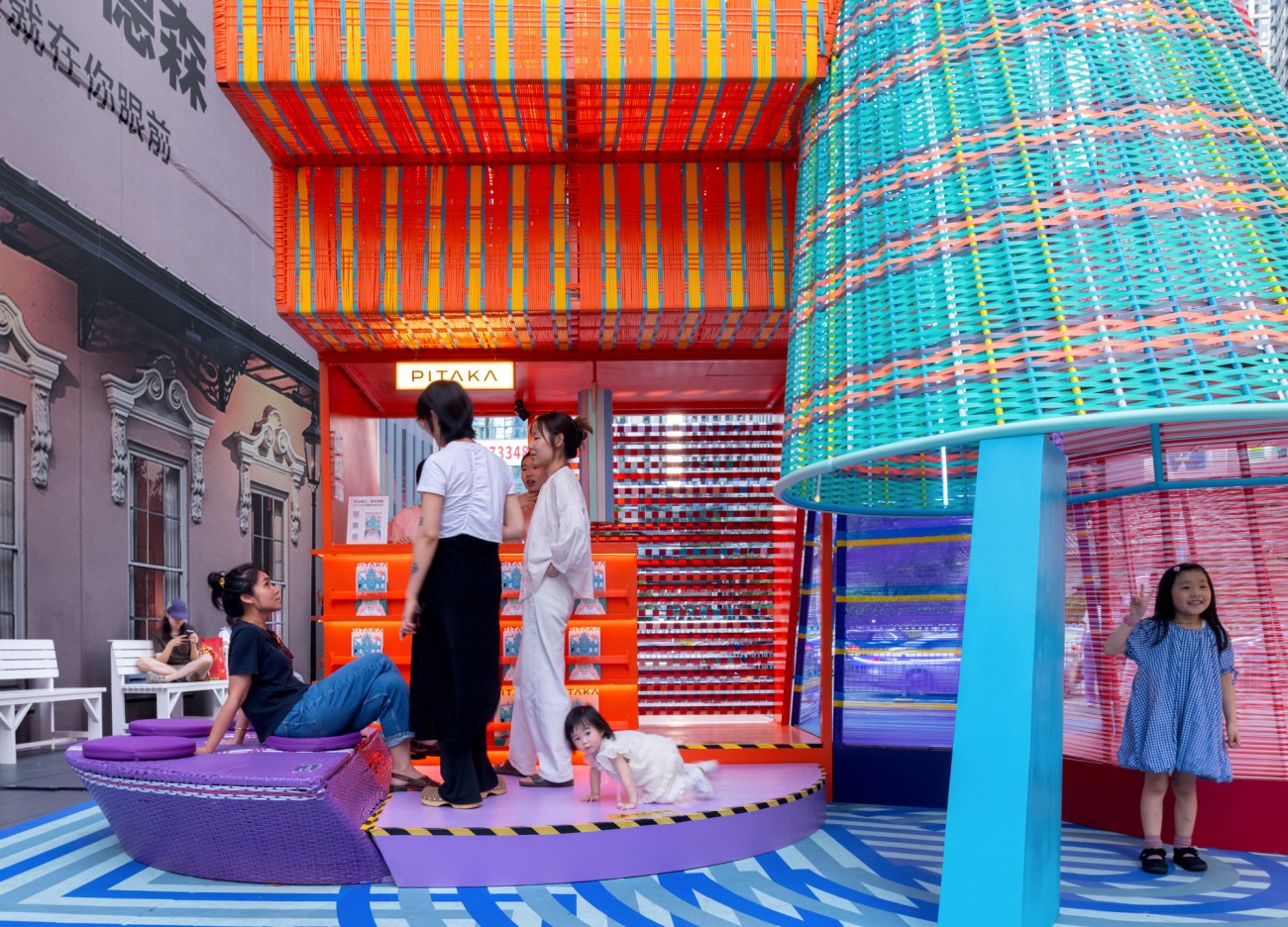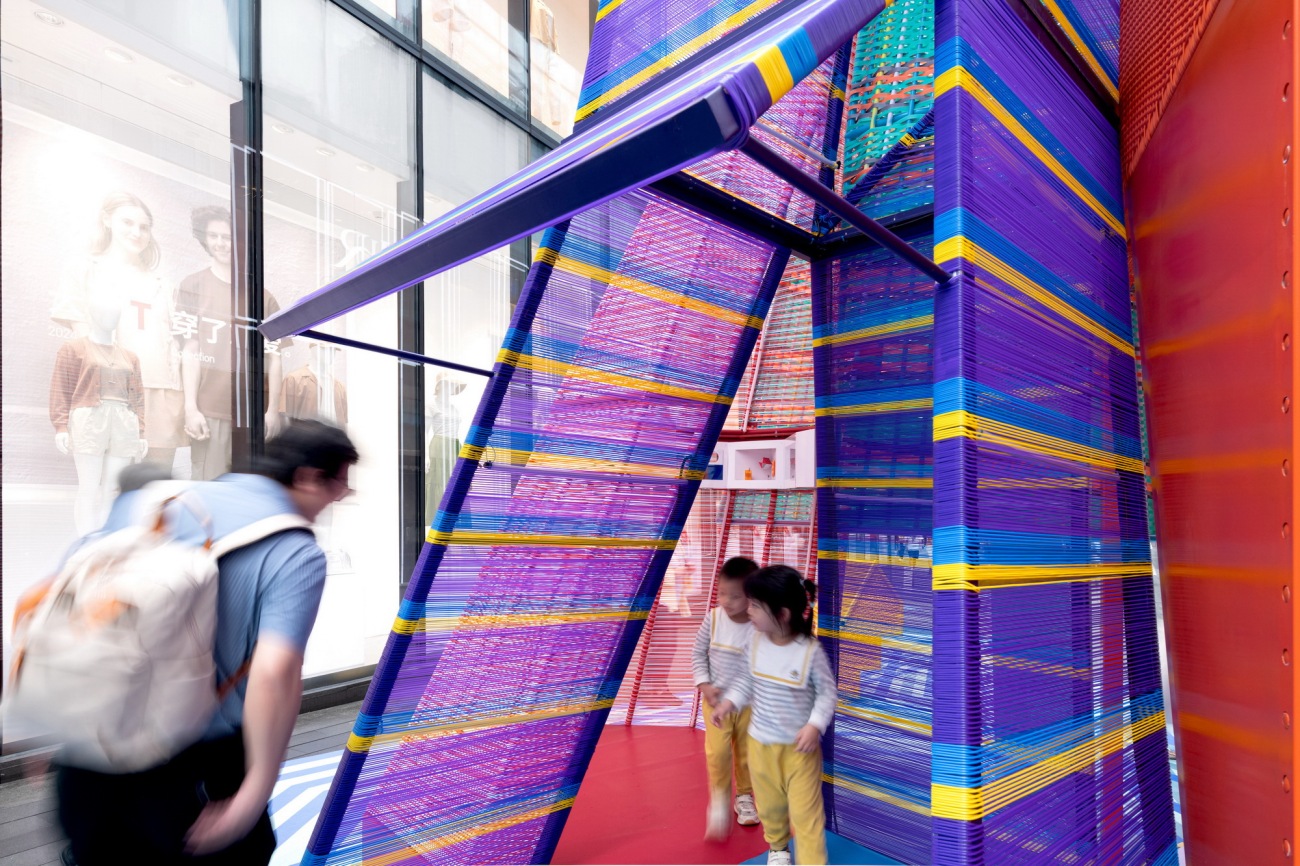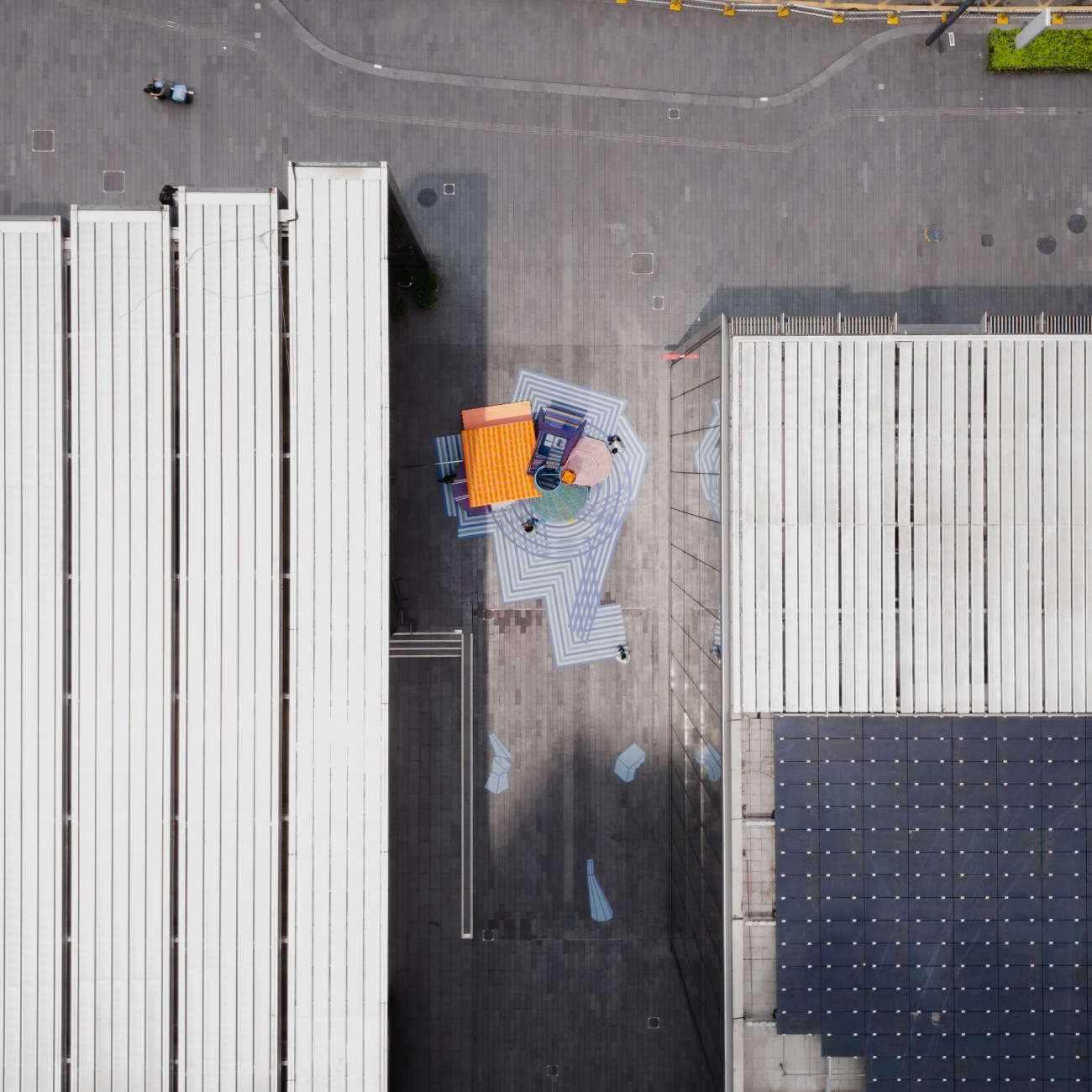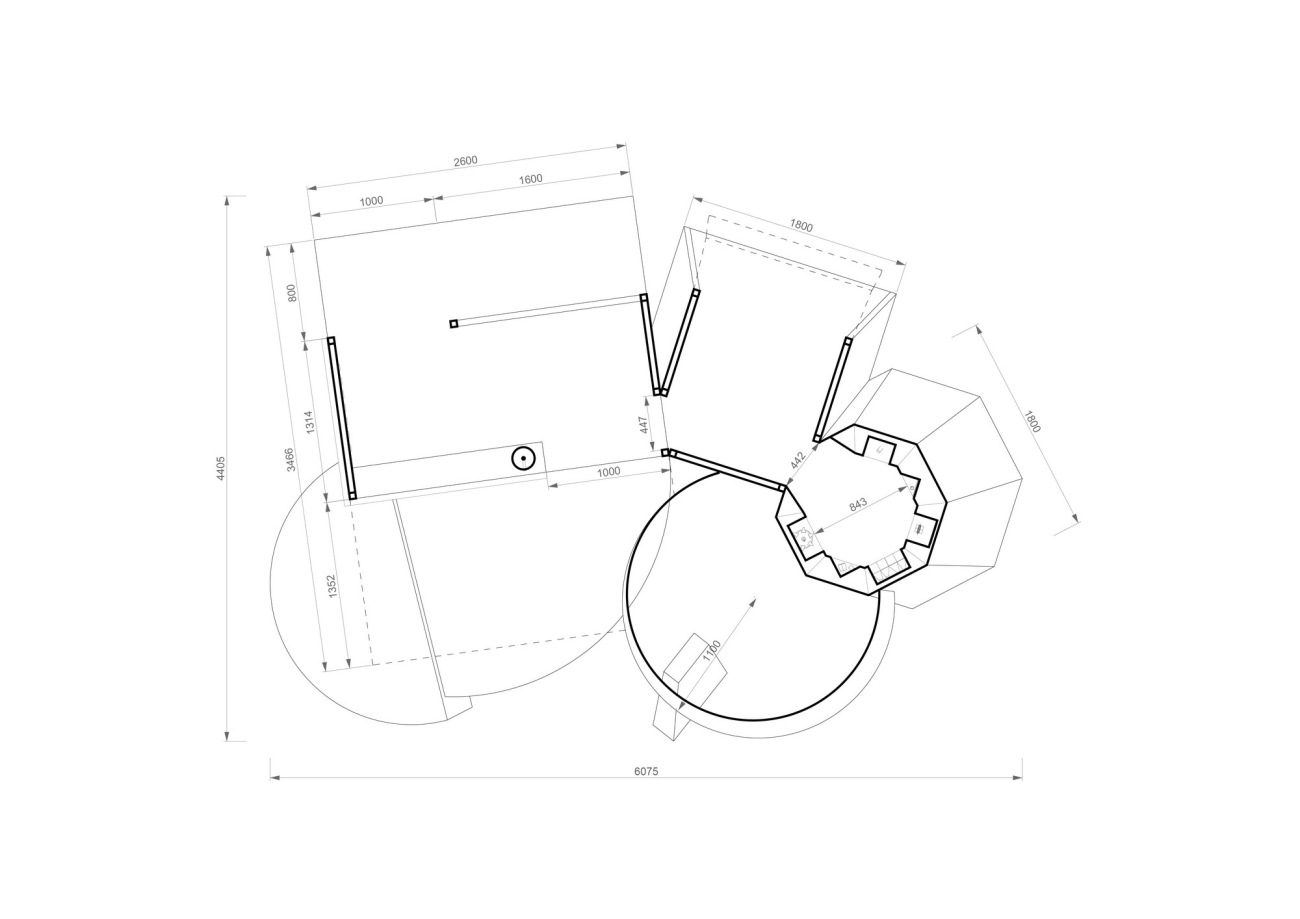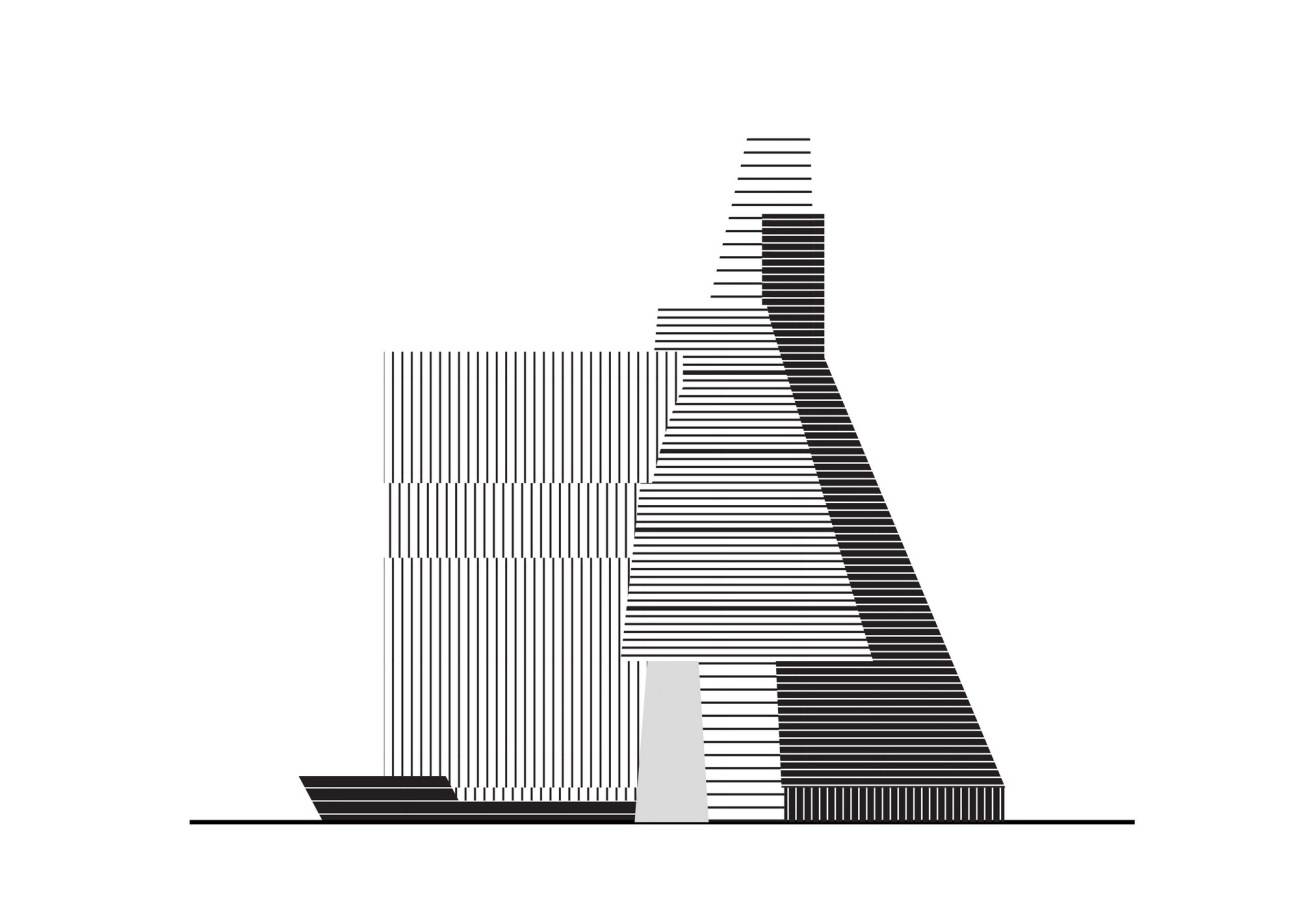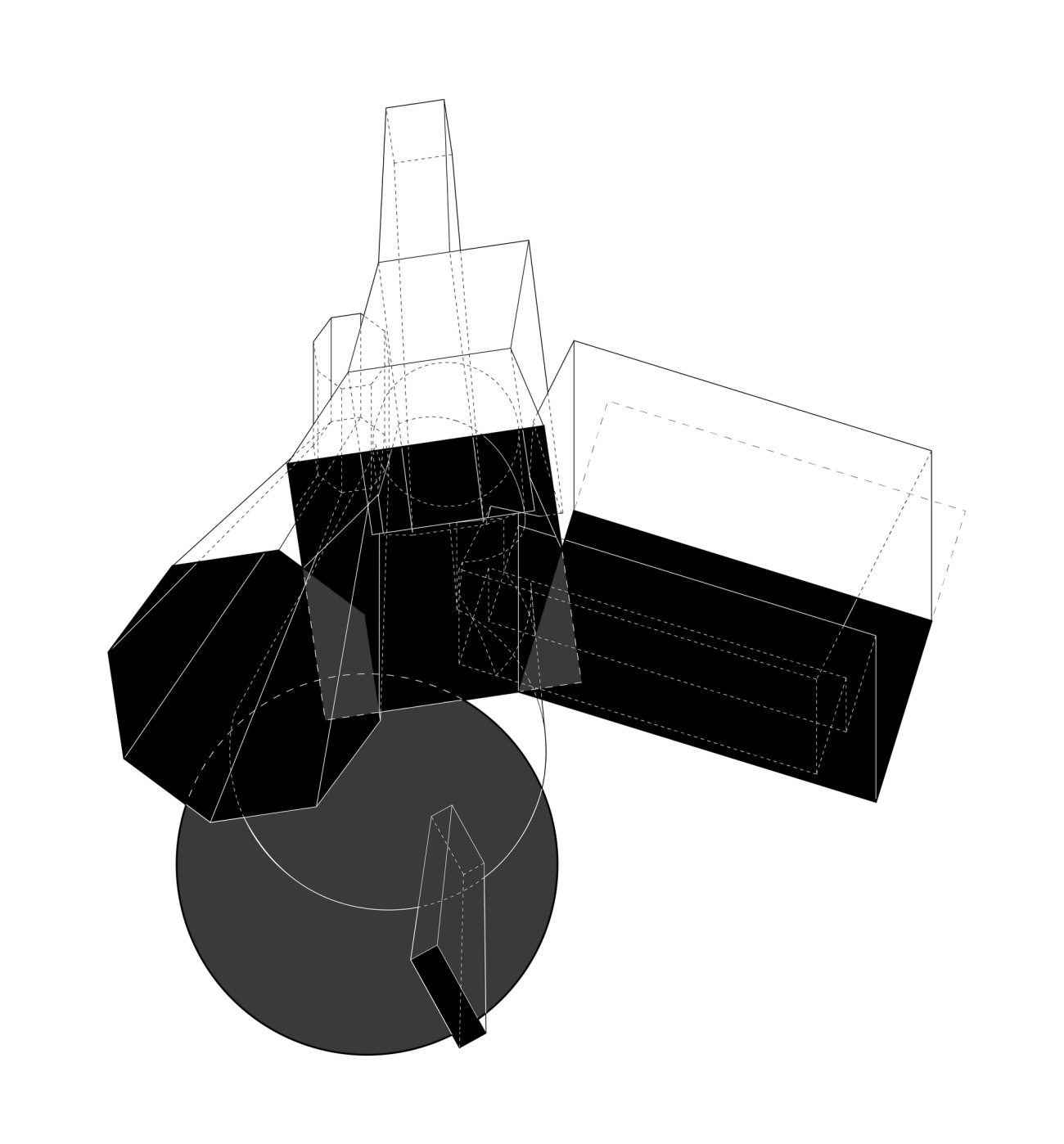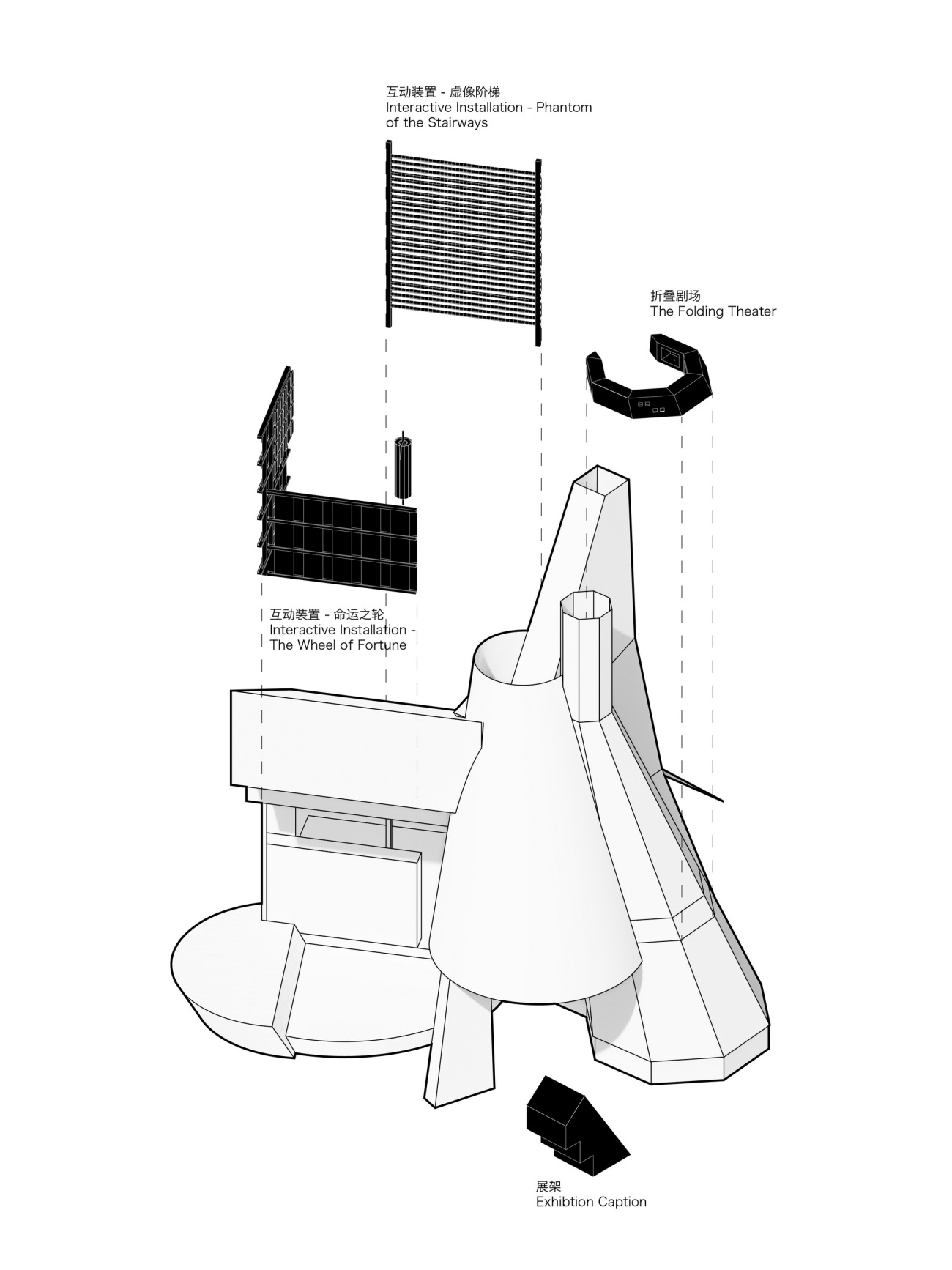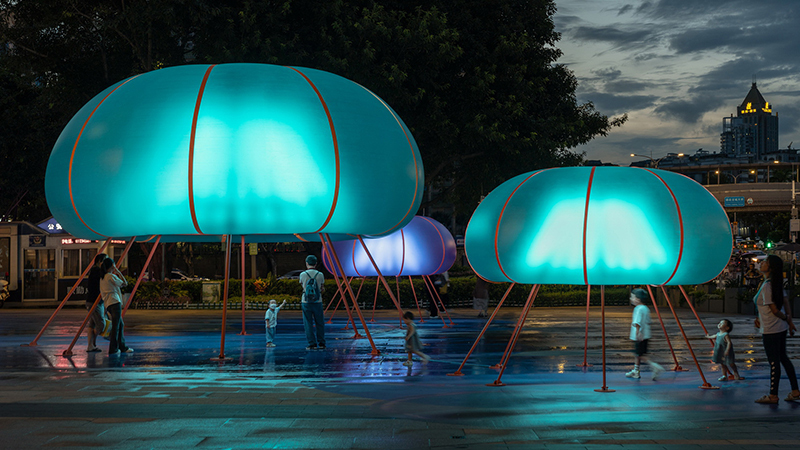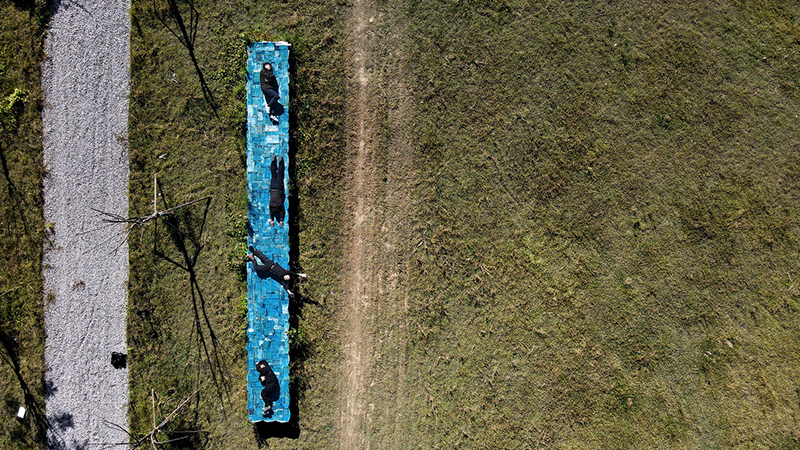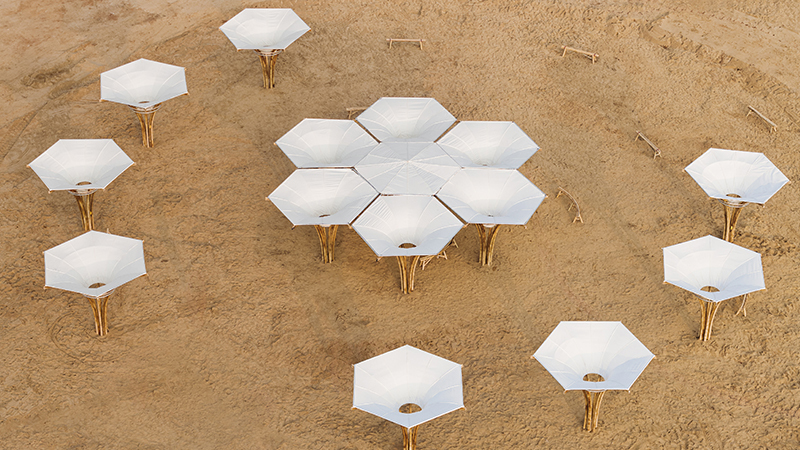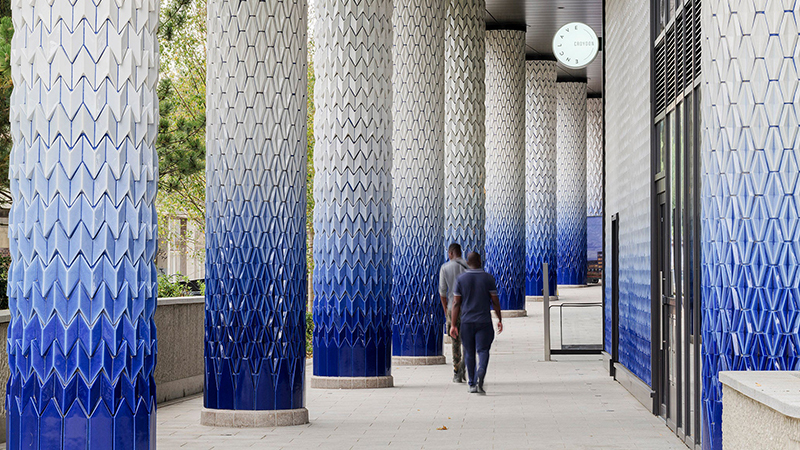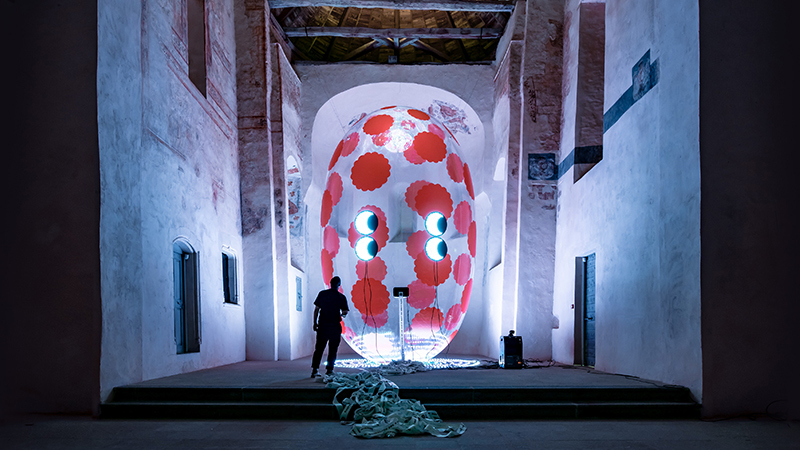▽“编织城市-织梦屋”公共艺术装置"Woven City-The House of Dream", a public art installation
▽“编织城市-织梦屋”公共艺术装置"Woven City-The House of Dream", a public art installation
2024年4月,大星吉子设计工作室受邀为PITAKA创作在《偶遇—韦斯·安德森》(AWA)中国首展上的特别主题艺术装置。本次展览由影迷在世界各地收集的“韦氏美学”城市影像切片组成,各类建筑物的图像以相同的透视角度被蒙太奇式地排列组合,看似是城市类型学的分类,更是无数人们关于城市记忆的叠加。
In April 2024, Daxing Jizi Design was commissioned to design an art installation for PITAKA at the first “Accidentally Wes A nderson(AWA) ” exhibition in China, showcasing a global collection of images paying tribute to the distinctive visual style of filmmaker Wes Anderson. The meticulously curated images showcase buildings captured in a symmetrical arrangement, suggesting a classification of urban typologies while also delving into a profound narrative of individuals’ memories of the city.
呼应PITAKA“清醒梦游”主题,并延续大星吉子的“编织城市”系列作品思路,本次创作的“织梦屋”艺术装置,希望将编织的话题带入到更广阔的公共领域。不仅回应展览中的城市记忆影像,更希望织起关于城市空间的想象,通过一种充满戏剧色彩的场景感受,唤起人们对日常的全新认知,激发新的创造力。
In line with PITAKA’s yearly theme “Lucid Dreaming”, Daxing Jizi’s public art installation “The House of Dream” takes the craft of weaving to a larger audience. It doesn’t just mirror the city scenes featured in the AWA exhibition but also spins imaginative tales about cityscapes. Bursting with vibrant colors, the installation aims to shift perspectives on everyday life and spark fresh creativity among the visitors..
▽“编织城市”-织梦屋装置鸟瞰Aerial view of “Woven City - The House of Dream
▽将城市肌理与景观抽象呈现的“编织城市-织梦屋”装置“Woven City-The House of Dream”, an abstract representation of the intricate texture and landscape of the urban environment
装置占地面积18.5平方米,整体高7.4米,表面由耗时超过2000小时的手工编织制成,抽象地呈现出城市的肌理与景观。主体由四个色彩和形态各异的体块相互嵌合,组成开放式空间,提供可灵活漫游探索的场所。而“碰撞”与“微缩”的平行叙事,编织出双重维度的超现实体验。我们邀请观众进入这个梦境般的空间,在探索中产生新的感知。
Spanning 18.5 square meters and towering at 7.4 meters, the installation has been elaborately crafted over 2000 hours. Its surface, intricately hand-woven, abstractly captures the essence of urban textures and landscapes. Comprising four segments of varying colors and shapes that seamlessly interlock, it creates an inviting open site for unhindered exploration. The intertwined themes of “collision” and “microcosm” craft a surreal, dual-dimensional narrative. Guests are invited to immerse themselves in this ethereal realm, discovering fresh perspectives at every turn.
▽装置的街景视角The street view of “Woven City - The House of Dream
01 编织:关于“连接”的魔力
01 Weaving: The Magic of Connection
▽不同的编织肌理表现A diverse array of textures and their visual expressions
在这座虚拟与现实的交叠的“织梦屋”里,我们展开了一场关于编织的实验。编织是一门古老的技艺,它出现的时间甚至早于文字。无论从物理或精神层面,它都似乎有一种“连接”的魔力:经纬线交织的自然肌理、可呼吸的空隙、或柔软或坚韧的质地,都天然地传递着一种使人想要亲近和触碰的感受。
In “The House of Dream”, where the reality and the fiction overlap, we delve into an exploration of the art of weaving. Weaving, an ancient art preceding written language, possesses an enduring fascination. Its enchanting ability to connect—be it on a physical or metaphysical plane—lies in the intricate dance of warp and weft, the dynamic spaces in between, and the diverse textures that beckon individuals to engage and immerse themselves.
▽编织材料自然传递出的亲近感The weaving materials naturally exude a feeling of closeness.
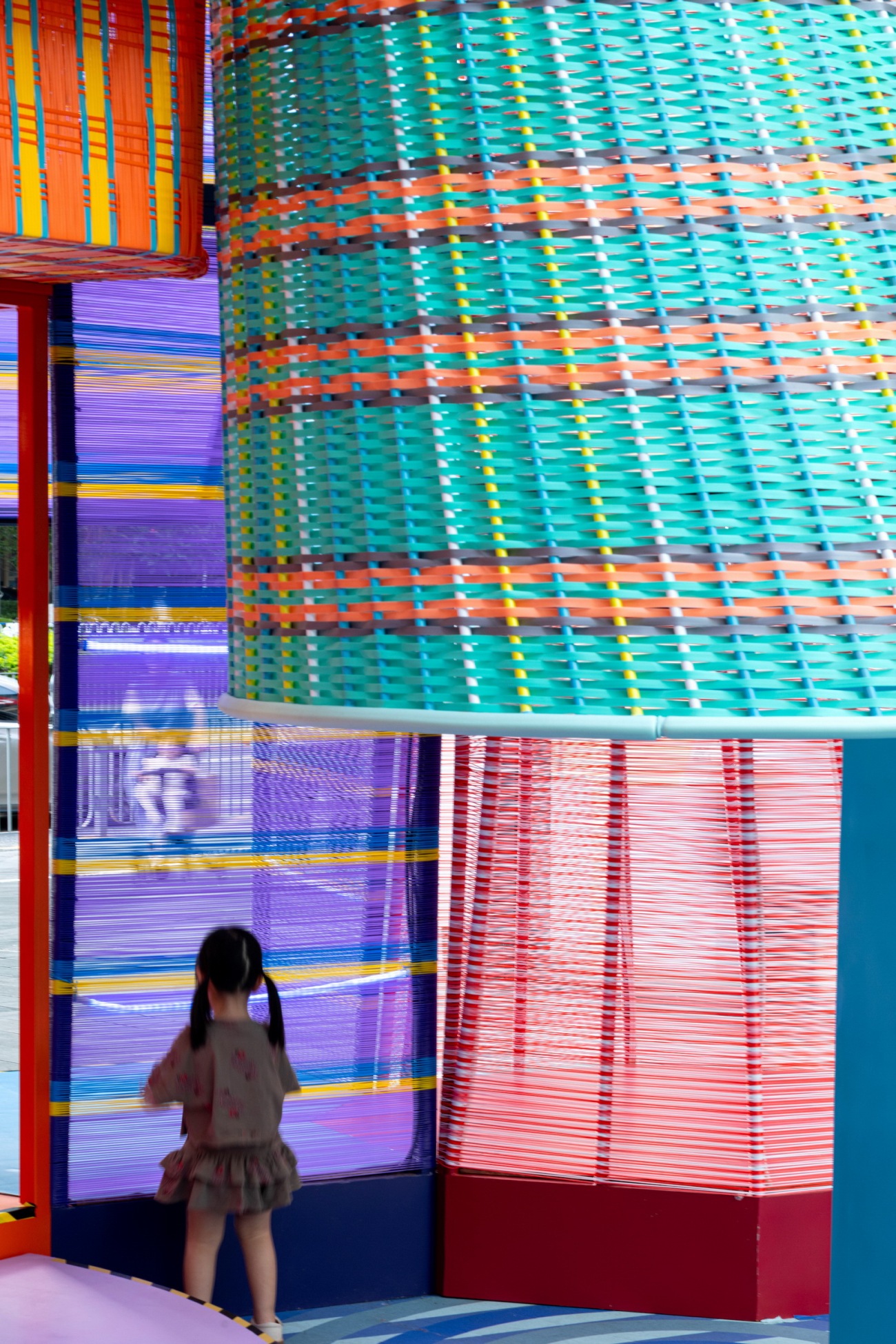 | 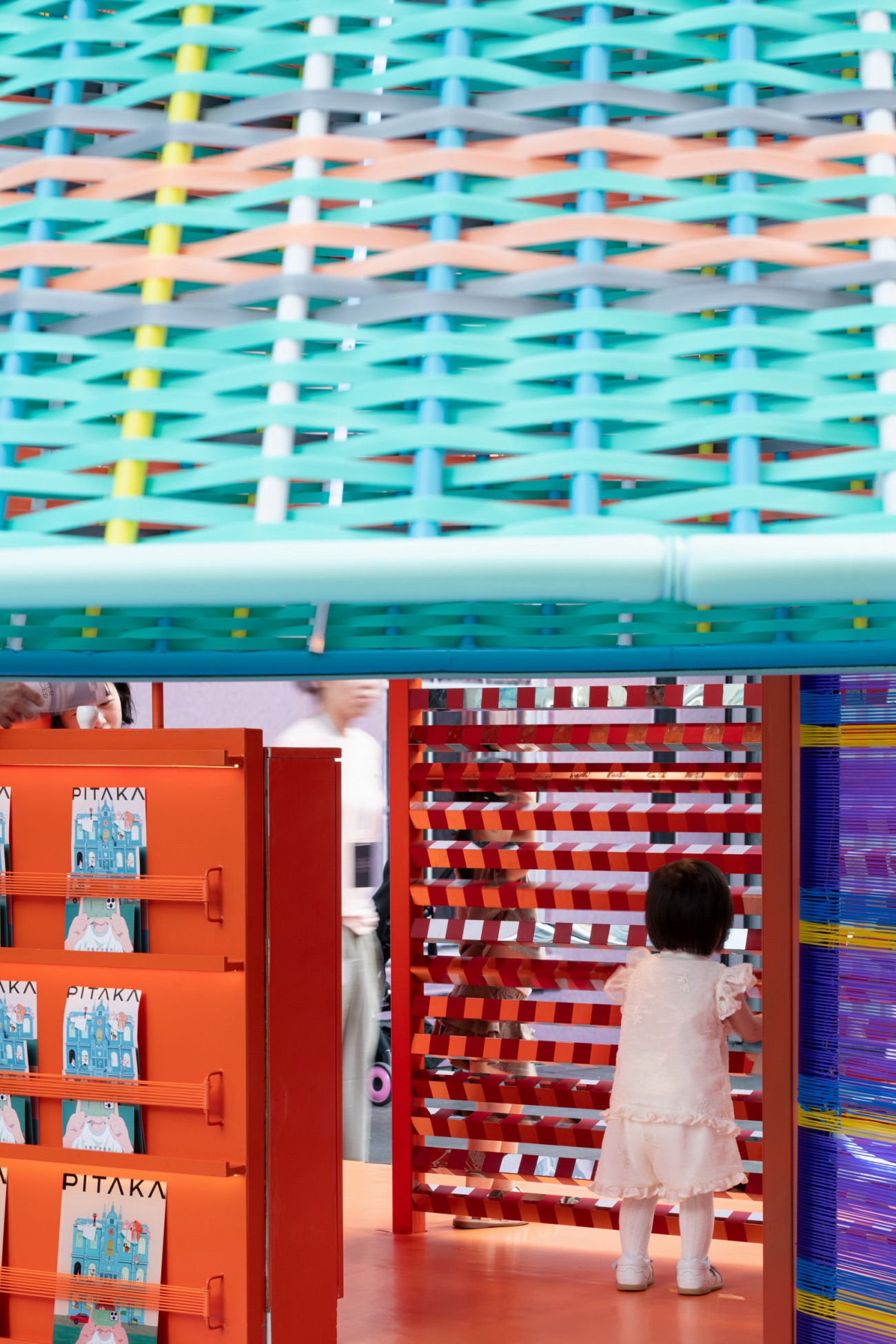 |
我们在设计中强化编织的“连接”属性,每一个体块内都精心设置了可体验的展陈细节,让观众自发去碰触和互动。我们选用塑料编织带与弹力绳作为主要材料,汲取PITAKA的纺织色彩,形成装置色彩跳跃、质感轻盈的表皮,并根据不同的空间特质,灵活运用三种编织技法:经典的经纬编织、混合金属杆件和软性材料的编织、绕线编织,带来丰富的肌理变化和视觉表现。
In our design, we have emphasized the interconnected essence of weaving by thoughtfully integrating interactive components in each segment to encourage tactile involvement and participation from visitors. Utilizing plastic weaving strips and elastic cords as primary materials, we have derived color schemes from PITAKA's distinctive designs to craft an installation imbued with lively Hues and a delicate feel. Tailoring our approach to suit the unique attributes of various spaces, we have employed three weaving techniques: traditional plain weave, a fusion of metal rods and supple materials, and wire-wrapping weave, resulting in a diverse array of textures and visual expressions.
▽不同技法的编织肌理Diverse textures achieved through different weaving techniques
通过环保的手法以及更经济的材料选择来达到降本增效、可持续设计的目标,是我们一直以来的探索方向。本次使用的编织材料在制作过程中没有产生额外的材料损耗,也无需使用任何胶水;展出结束后,这些材料几乎可以全部被回收,用于制作篮子、座椅等物品。
Our consistent goal has been to achieve cost reduction, enhance efficiency, and promote sustainable design through eco-conscious methods and budget-friendly material choices. The weaving materials utilized in the construction of “Woven City” left zero material waste during production and required no adhesive. Following the exhibition, the majority of these materials can be recycled and repurposed for crafting items such as baskets and seats.
▽厂房内的编织协作Workers collaborate in the weaving workshop
▽厂房内的编织协作Workers collaborate in the weaving workshop
而编织的魅力也不仅仅在于最终呈现出的结果。在上千平米的宽阔厂房内,大星吉子团队、PITAKA团队以及十多名工人共同进行了编织创作,编织时间超过2000小时,面积超过80平方米。不同群体的轨迹交织凝聚在这座独特的纯手工编织建筑装置中,展示了创作的开放性和跨界协作的可能性。
The fascination of weaving extends beyond the final product. In an expansive workshop covering thousands of square meters, Daxing Jizi’s team, in collaboration with PITAKA’s team and a dozen workers, dedicated over 2000 hours to meticulously craft a creation surpassing 80 square meters. In the workshop, the paths of different teams intersect and converge, illustrating the spirit of creative openness and the possibilities of interdisciplinary cooperation.
02 碰撞与微缩:双重空间叙事
02 Collision and Microcosm: Dual-Dimensional Spatial Narrative
▽“编织城市-织梦屋”公共艺术装置"Woven City - The House of Dream", a public art installation
城市如同剧场,每一种特定的空间场所承载着不同的事件和相应的记忆,我们居住在城市的物理空间里,也居住在自己的记忆和想象中。阶梯、灯塔、烟囱、小房子……我们从AWA展览的上千张影像中选取了四种代表城市记忆的场所作为空间灵感,它们既是城市的精神象征,也是集体记忆的片段;PITAKA芳纶织布机和转动的纺锤,同样成为设计的灵感元素。
Cities function as grand theaters, with each distinct space and site preserving its own collection of memories. As residents, we inhabit not just the physical urban landscape but also within the realm of our personal memories and limitless imaginations. From the thousands of images in the AWA exhibition, we selected four representative places symbolizing urban memories as inspiration for the installation: stairs, lighthouses, chimneys, small houses. They are not only symbols of the city's spirit but also fragments of collective memory; PITAKA’s aramid fibre weaving machine and rotating spindles also served as inspirational elements in the design.
▽空间灵感与四个功能体块Diagram of the four segments
我们编织出双重维度的空间叙事:在第一重维度“碰撞空间”里,灵感元素的原型变形、重组,在扭曲的格网中以非理性的方式碰撞和融合,形成四个空间体块,对应不同的个性、色彩和编织肌理,组成装置的主体形象。
We developed a dual-dimensional spatial narrative. In the initial dimension named “Space of Collision”, the prototypes of inspiration sources undergo a metamorphic journey, colliding and blending within a distorted grid, giving rise to four spatial segments characterized by different personalities, colors, and woven textures. Together, they form the main structure of the installation.
▽装置的街景视角The street view of “Woven City - The House of Dream
▽装置主体形象The main structure of the installation.
第二重维度“折叠剧场”中,装置体块被无限缩小为物件,在主体内部形成微缩景观,建筑成为剧场角色,内外关系被颠倒,编织材料成为被观赏的画作……时空在此坍缩、交错,观众得以走入另一层虚构叙事,观察平行的世界。
In the second dimension named “Folding Theater”, the four segments of the installation undergo a significant reduction, transforming into tiny objects that form miniature diorama within the main structure. Buildings assume roles as characters within the theatrical setting, while the dynamic between interior and exterior is inverted. The woven materials transition into pieces of art to be appreciated. Here, time and space converge, enabling visitors to traverse into an alternate realm of narrative, witnessing a parallel universe.
▽在折叠剧场中,装置体块被无限缩小为物件In “Folding Theater”, the segments are reduced to small objects
▽“折叠剧场”微缩景观dioramas in “Folding Theater”
整座装置向城市界面充分打开,观众可以从不同的方向进入空间内部,探索各个体块;编织的半透明肌理模糊了现实中的城市空间和装置的内部体验,人们在这里穿越城市的精神和物质景观,触摸真实或经历幻象。
The installation embraces the city, inviting visitors to enter from all directions and fully engage with each segment. The semi-transparent weaving textures delicately blur the lines between the external urban surroundings and the dreamlike realm inside the installation. Visitors are able to navigate through the spiritual and material landscapes of the city, interacting with both the tangible reality and fleeting illusions.
▽装置从各个角度向城市空间打开The installation opens up to the urban space from all directions
▽模糊内与外的编织界面The blurred boundaries between the inside and outside of the installation
03 漫游:四幕梦境的感知
03 Roaming Through a Four-Act Dream
我们写下四幕关于梦境的电影剧本,邀请观众在想象与现实叠加的空间内漫游。
We developed a four-act script exploring the realm of dreams, inviting visitors to navigate the space where imagination and reality are superimposed.
●第一幕:虚像阶梯
●Act I: Phantom of the Stairways
▽梦境的入口——“虚像阶梯”Entrance to the dream - the “Phantom of the Stairways”
装置中的橘色空间体块形态是一个倒置的阶梯,其灵感来自《布达佩斯大饭店》中的入口电梯。作为第一幕空间,内部设置了两处互动内容:一处是位于入口前侧的竖向彩色滚轴“命运之轮”,观众通过转动和触摸感受滚轴上编织材料的特性并“进入”场景。四种色彩也象征着不同的梦境,滚轴停止旋转时,指针将指向不同的命运。
The orange segment embodies an inverted staircase design, drawing inspiration from the iconic elevator featured in “The Grand Budapest Hotel”. This area serves as the setting for the first act and houses two interactive elements. The first is the vibrant revolving gate, the “Wheel of Fortune", positioned at the entrance, where visitors can engage with the weaving materials’ tactile qualities as they rotate the mechanism to access the installation. The revolving gate’s four distinct colors represent varied dreams, with the pointer indicating diverse destinies when it comes to a halt.
▽“虚像阶梯”内的互动装置墙Interactive wall inside the “IPhantom of the Stairways”
另一处则是可翻转的互动装置墙,镜面与红色方块交错出现,映出周围的城市景象和观众的身影,带来虚实相间的视觉乐趣。
Another interactive feature in the segment is a wall adorned with rollable cubes, each adorned with mirrors or a striking red surface. These cubes reflect the ever-changing cityscape and the presence of visitors, offering a captivating visual spectacle that dynamically engages the senses.
“命运之轮”的微缩场景中,滚轴横置于镜面三角顶部,昭示着梦境进入机制的神圣和随机性。“虚像阶梯”的微缩场景中,阶梯与镜面互动装置的尺度对调,以体现梦境的无限和大小的失序。
In the diorama of the “Wheel of Fortune”, the horizontal placement of the revolving gate on the mirrored triangular pyramid signifies the mystical and unpredictable essence of entering the realm of dreams. Within the intricate setting of the “Phantom of the Stairways”, the staircase’s dimensions are diminished to match those of the cube, symbolizing the limitless and tumultuous nature of dreams.
●第二幕:游丝线轴
●Act II: Threads of the Spool
▽从“游丝线轴”体块内部仰望Looking up from inside the “Threads of the Spool”
青色体块灵感来自织机工坊的“线轴”,它以悬置的状态半漂浮于主体之中。“游丝线轴”打破传统的编织手法,将坚硬的钢管作为经线,与柔软的纬线一同织出梦境的虚实交错。横向的编织带一圈圈向上叠加,形成环形延伸空间。从底部向上望去,仿佛置身于一个放大的线轴内部,意识在此缠绕。
The inspiration for the blue segment stems from the “Threads of the Spool” commonly seen in weaving workshops, positioned in a suspending manner in the main structure. Deviating from traditional weaving techniques, the “Threads of the Spool” utilizes rigid steel fins as warp threads, weaving a dream together with soft weft threads. The horizontal strips are skillfully structured in circular arrangements, resulting in a circular space that expands vertically. When observing from below, the sensation of being enveloped within an enlarged thread spool evokes a feeling of intricate interconnection.
“游丝线轴”微缩场景以重复阵列的线轴作为后景,前景中一个孩童将丝线从线轴体块中扯出,一位攀登者则从编织线上下降。
Within the diorama of the “Threads of the Spool”, a child in the foreground unravels thread from the scaled spool, as a climber descends using a woven thread.
●第三幕:维度天空
●Act III: Dimension of the Sky
▽“维度天空” 体块The inspiration for the “Dimension of the Sky”Photo by: HU Kangyu
“维度天空”体块的灵感来自电影中的烟囱和灯塔,采用绕线编织形成的蓝色和红色空间是整个主体的最高点,四边和八边的形状从底部到顶部不断变形,创造出观察天空的多重孔洞。
The inspiration for the “Dimension of the Sky” is derived from the chimneys and lighthouses seen in Wes Anderson’s movies. Nestled at the peak of the installation, the blue four-sided space and the red eight-sided space undergo a graceful transition as they rise, forming several openings that encourage sky gazing.
▽“维度天空”内部的折叠剧场场景“Dimension of the Sky” inside the “Dimension of the Sky” Photo by: HU Kangyu
两重空间维度在这个体块的底部相遇,观众可以通过横向的孔洞观赏“折叠剧场”的六个微缩模型。
At the base of this segment, the two spaces converge, providing visitors with a view through horizontal openings of six miniature scenes from the “Folding Theater”.
“维度天空”对应两个微缩场景,场景一是两个反向的望远镜,圆形重叠组成的窗口里是无限延伸的潜水世界。
场景二以红色体块的横向编织线为背景,中间的红色筒状体块腰部延伸出数个孔洞,象征可阅读的空间。
Two diorama are inspired by the “Dimension of the Sky”.
In the first scene, two reverse telescopes reveal an infinitely extending underwater world through their lenses.In the second scene,a backdrop of intertwined threads reminiscent of the red space forms the setting, with diverse elements protruding from the openings on the midsection of the red cylinder in the foreground, symbolizing a narrative space.
●第四幕 相遇坐标
●Act IV: The Axis of Encounter
▽独立于主体之外的“坐标”“The Axis of Encounter” independent of the main structure
装置中的黄色体块和紫色体块是“虚像阶梯”形态的延伸。黄色体块承载着装置的介绍信息,独立于主体之外并与其形成互文关系。观众从装置主体内部的各个角度都可以透过半透明的编织表皮观察到它的存在,从而标定自身和对方的位置,形成短暂的相遇。
The form of the “Phantom of the Stairways” is echoed in the yellow and purple segments. The yellow segment, housing introductory information about the installation, stands independently from the main structure yet engages in a dialogic interplay with it. Inside the main structure, visitors can peer through the translucent woven wall at the yellow segment from diverse angles, establishing a momentary connection that highlights both their own presence and that of the segment.
而紫色体块则提供了一个较长时间的停留空间,结合阶梯和座椅的功能,观众和行人可在此翻阅画册或休憩交谈,使这里成为多重意义上的相遇场所。
The purple segment offers a versatile space for extended stays, seamlessly blending the utility of a staircase with comfortable seating. Here, visitors and passersby can leisurely browse through catalogs, relax, and engage in conversations, transforming this area into a multifaceted meeting point with rich significance.
▽公共艺术装置作为相遇的场所The public art installation as a meeting point
04 结 语
04 Final Thoughts
韦斯·安德森将空间表达为充满幻象的舞台,“编织城市”以此为美学启发,用编织的空间语言,与人们共同创造,去表达和连接这个世界,在视觉体验为主导的公共艺术领域,为城市公共空间提供无法替代的切身体验,可触摸的质感和非常规的空间探索方式,都让观众真正参与其中。
Through Wes Anderson’s lens, space transforms into a stage ripe with mesmerizing illusions. “Woven City” embraces this vision, leveraging the art of woven space to co-create, express, and forge connections with society. In a realm typically dominated by visual spectacles, the installation delivers unique immersive experiences for urban environments, encouraging visitors to interact with its tactile textures and innovative spatial storytelling.
▽探索空间的小观众Young visitors exploring the space
在社交媒体蚕食城市生活的今天,虚拟空间以及碎片化的信息使人们封闭在自己的房间里,而城市场景逐渐演化成了一种背景和功能性的存在。我们希望装置能创造一种“对日常的觉醒”,让人眼前一亮的同时,传达对于城市感知的理解,鼓励人们不仅仅是用眼睛,而是用身体和心灵去体验世界。
In today’s society, where social media saturates urban life and virtual spaces confine people indoors, cityscapes often serve as mere functional backgrounds. Our goal with the installation is to ignite a “reawakening to the ordinary”, offering a revitalizing experience that cultivates a heightened urban consciousness. By encouraging people to interact not only visually but also physically and intellectually with their environment, we seek to enhance their bond with the world.
▽“编织城市”装置鸟瞰Aerial view of the “Woven City”
▽平面图 Installation Plan
▽立面图 Installation Elevation
▽轴测图 Installation Axonometry
▽折叠剧场技术图Folding theater technical drawing
项目信息:
Project Info:
项目名称:PITAKA x 偶遇-韦斯·安德森展览主题艺术装置
设计单位:大星吉子设计工作室
项目总监:谢琼枝
主创设计师:陈滢潇
编织设计:殷晖
展览叙事及互动展品设计:周天
项目监制:曾镇威
宣传支持:肖才子
摄影:胡康榆、禁止影像、周天
施工单位:尚匠创意智造
编织团队:候辉、马红灵、可可、庞俊雷、熊留住、娜娜、晓兰、李中付、李亚楠、刘倩等
项目委托方:PITAKA
项目面积:24平方米
项目地点:深圳市万象天地
完工时间:2024.5.1
展期:2024.5.1-2024.7.30
Project Name: Public Art Installation for PITAKA x AWA, The Exhibition
Design: Daxing Jizi Design
Director: XIE Qiongzhi
Chief Designer: CHEN Yingxiao
Weaving Design: YIN Hui
Narrative and Interactive Design: Zhou Tian
Supervisor: ZENG Zhenwei
Promotion support: XIAO Caizi
Photography: HU Kangyu, No Photos Studio/JZ Photo Studio, Zhou Tian
Construction: Shangjiang Creative Tech
Weaving: HOU Hui, MA Hongling, Keke, PANG Junlei, XIONG Liuzhu, Nana, Xiaolan, LI Zhongfu, LI Ya-nan, LIU Qian, and others
Client: PITAKA
Project Footprint: 24 m2
Location: MixC Shenzhen
Completion Date: May 1, 2024
Exhibition Duration: May 1, 2024 - July 30, 2024
更新日期:2024-06-12 15:56:11
非常感谢 大星吉子设计 带来的精彩项目, 查阅更多Appreciations towards Daxing Jizi Design for sharing wonderful work on hhlloo. Click to see more works!
